Boston Scientific CRM649812 6498 User Manual
Boston Scientific Corporation 6498
User Manual

PATIENT MANUAL
PATIENT MANUAL
PATIENT MANUAL
PATIENT MANUAL
Caution: Federal (USA) law
restricts this device to distribution
and use by or on the lawful order of
a physician.
LATITUDE® Communicator
LATITUDE® Communicator
LATITUDE® Communicator
LATITUDE® Communicator

LATITUDE is a registered trademark of Boston Scientic Corporation
or its afliates.
Delta Mobile Systems is a trademark of Delta Mobile Systems
GlobTek is a registered trademark of GlobTek, Inc.

1
LATITUDE® Communicator Patient Manual
Table of Contents
LATITUDE Patient Management 3
The LATITUDE Communicator 3
Items You Should Receive 4
Optional Health Monitoring Equipment 5
Clinician Website 5
When to Use Your Communicator 6
When Not to Use Your Communicator 6
Where to Place Your Communicator 7
Important Notes 7
Identifying Buttons, Connectors and Indicators 9
How to Connect Your Communicator 10
Connections When Using a Telephone 11
Connections for the LATITUDE Cellular Data
Plan 14
Normal Operation of the Communicator 16
Indicator Sequence When Using the Heart Button 17
Indicator Descriptions 19
Status Button 24
Conrming Normal Operation 25
Troubleshooting Errors 27
Wave Indicator Colors 32
LATITUDE Cellular Data Plan 41
Activating the LATITUDE Cellular Data Plan 41
Troubleshooting and Support 42
Discontinuing Your LATITUDE Cellular Data
Plan 42
Interrogating Your Implanted Device 43

2LATITUDE® Communicator Patient Manual
What to Do if the Electrical Power is Interrupted 44
Checking that the Communicator Can Connect to
LATITUDE 45
Traveling with Your Communicator 46
Communicator Use of the Telephone System 46
What to Do If You Need to Use the Telephone
While the Communicator is Making a Call 48
DSL Internet Service 48
Care and Maintenance 49
Cleaning the Communicator 49
Returning or Replacing the Communicator 50
Communicator Disposal 50
Setting Switches for Your Country 51
Setting Switches for PBX or Dial-out Numbers 52
Connecting the USB Adapter 53
Specications 53
Safety and Standards Compliance 56
Software 58

3
LATITUDE® Communicator Patient Manual
LATITUDE Patient Management
LATITUDE Patient Management is a remote monitoring
system that gives your health care provider access to
your implanted device data between scheduled ofce
visits. The LATITUDE system is designed to improve
patient care while providing convenience to you.
The LATITUDE system uses advanced security
methods to protect your personal medical information.
Only authorized health care providers have access to
your information through the secure clinician website.
The LATITUDE system is not intended to assist with
medical emergencies. If you are not feeling well, call
your health care provider or dial 911.
The LATITUDE Communicator
The LATITUDE Communicator is an in-home
monitoring system that uses a wireless communication
system to communicate with your implanted device.
The Communicator does not provide continuous
monitoring. It automatically reads implanted device
information at times scheduled by your health care
provider.
At scheduled intervals, the Communicator sends
your device data to the LATITUDE system through a
standard telephone line or over a cellular data network
using the LATITUDE Cellular Data Plan (see page
41). The Communicator receives periodic schedule
updates made by your health care provider when it
connects to the LATITUDE system.
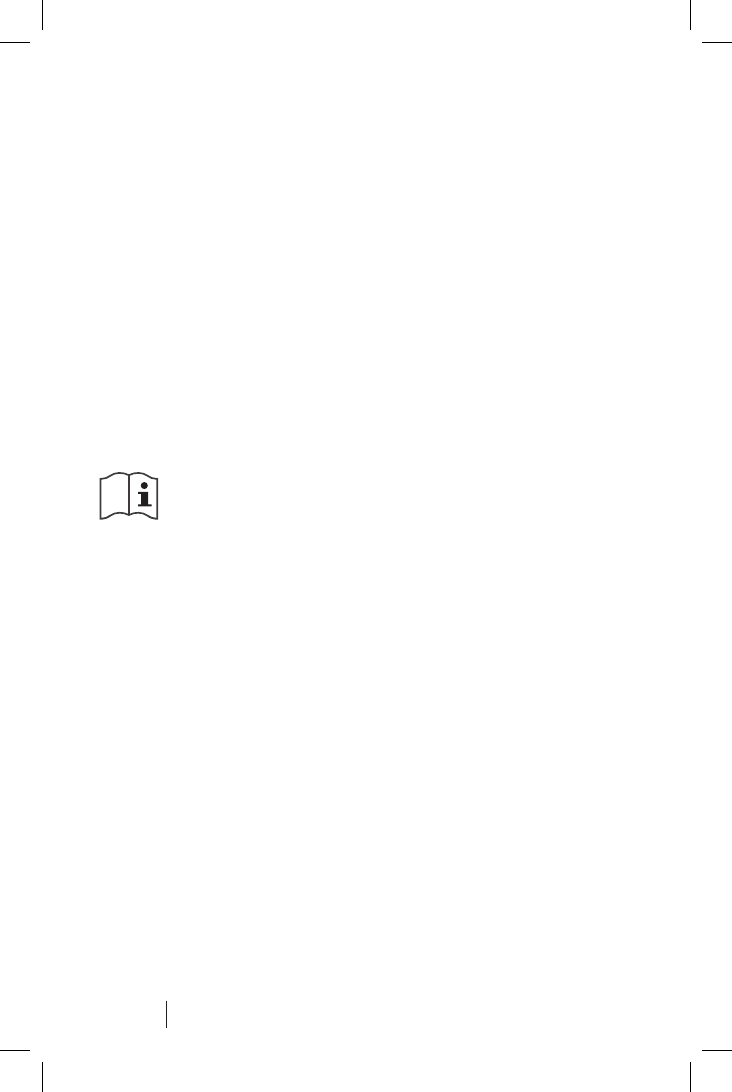
4LATITUDE® Communicator Patient Manual
The Communicator does not reprogram or change any
functions of your implanted device. Only your health
care provider can do this during an ofce visit.
Your Communicator is designed to be used only in the
United States, Canada, and Puerto Rico.
The telephone (land line) feature of the Communicator
is designed to operate on standard telephone lines
like those found in most homes. The Communicator
supports tone dialing over an analog line. The
Communicator may work on other telephone systems,
such as Digital Subscriber Line (DSL) and Voice over
IP (VoIP), if those systems provide an analog interface
for connecting the Communicator.
Read the instructions in this manual
thoroughly before using the Communicator.
Keep all of your LATITUDE information in a
convenient location for easy access in the
future.
Items You Should Receive
The following items are included with the
Communicator:
• Communicator unit
• AC adapter (GlobTek® Model GTM41060-1505)
• Communicator installation guide
• Communicator patient manual (this book)
• Accessories:
• Communicator telephone cord

5
LATITUDE® Communicator Patient Manual
Optional Health Monitoring Equipment
If prescribed by your health care provider, your
Communicator can also collect information from
an optional LATITUDE Heart Failure Management
System. This system includes a LATITUDE Scale and
LATITUDE Blood Pressure Monitor.
These specially designed products provide additional
information to monitor your health. Refer to the
handbook that is included with the weight scale and
blood pressure monitor products.
An accessory for the Communicator is a USB adapter
that is included with the scale and blood pressure
monitor.
Clinician Website
The clinician website provides authorized health care
providers a convenient and secure way to obtain and
analyze information from a patient’s implanted device.
The LATITUDE system normally displays your device
information on the clinician website within 15 minutes.
However, it may take longer for your information to
appear due to many external factors.
The website provides advanced analysis and trending
tools designed at improving patient care. Only your
physician and medical personnel authorized by
your physician can access your medical data on the
password-protected clinician website.

6LATITUDE® Communicator Patient Manual
When to Use Your Communicator
The Communicator performs many functions
automatically on a regular schedule that is set by
your health care provider. Other functions require you
to respond when the indicators on the front of the
Communicator light or ash. Check the Communicator
daily to see if any of the indicators are lit or ashing.
Use the Communicator only as instructed by your
health care provider. The Communicator’s Heart button
(Figure 1 on page 9) may ash if it needs you to
manually complete a scheduled interrogation of your
implanted device. If the Heart button is ashing, press
it and then watch the indicators on the Communicator.
Call your health care provider if the Call Doctor icon
(Figure 2 on page 10) is lit.
When Not to Use Your Communicator
The Communicator is designed to work only with your
implanted device. It will not work with another patient’s
implanted device. The Communicator should be used
only as authorized by the prescribing physician. The
Communicator is not for use with any pulse generator
other than a Boston Scientic device.
Ask your health care provider if you have questions
about any risks with using the Communicator or your
implanted device. There is also valuable information
about risks and reliability in the patient handbook for
your implanted device.

7
LATITUDE® Communicator Patient Manual
Where to Place Your Communicator
Place your Communicator:
• Near a telephone wall jack (not required if you are
subscribed to the LATITUDE Cellular Data Plan).
• Near an electrical outlet that is easily accessible.
• Where you can sit comfortably and see the front
of the Communicator.
• Close to where you sleep or near your bedside.
If this is not possible, place your Communicator
where you spend a considerable amount of time
each day.
Important Notes
• It is very important that the Communicator remain
plugged into the electrical outlet.
• Your Communicator should remain connected to
a telephone line unless you are subscribed to the
LATITUDE Cellular Data Plan.
• This equipment needs to be installed and put into
service in accordance with the information in the
provided documentation. Call your health care
provider if you need assistance setting up or using
your Communicator.
• Some household appliances and other sources of
electromagnetic energy could interfere with wireless
communication between the Communicator and
your implanted device. When you are using the
Communicator, you should be at least 3 ft (1 m)
away from televisions, VCRs, DVD players, personal
computers, and other electronic equipment.

8LATITUDE® Communicator Patient Manual
• Electrical safety: It is recommended that the customer
install a surge protector between the electrical
wall outlet and the Communicator. This is to avoid
damage to the Communicator caused by local
lightning strikes and other electrical surges.
• Boston Scientic personnel may contact the clinic
or patient if an implanted device uses too much RF
telemetry to perform remote interrogations.
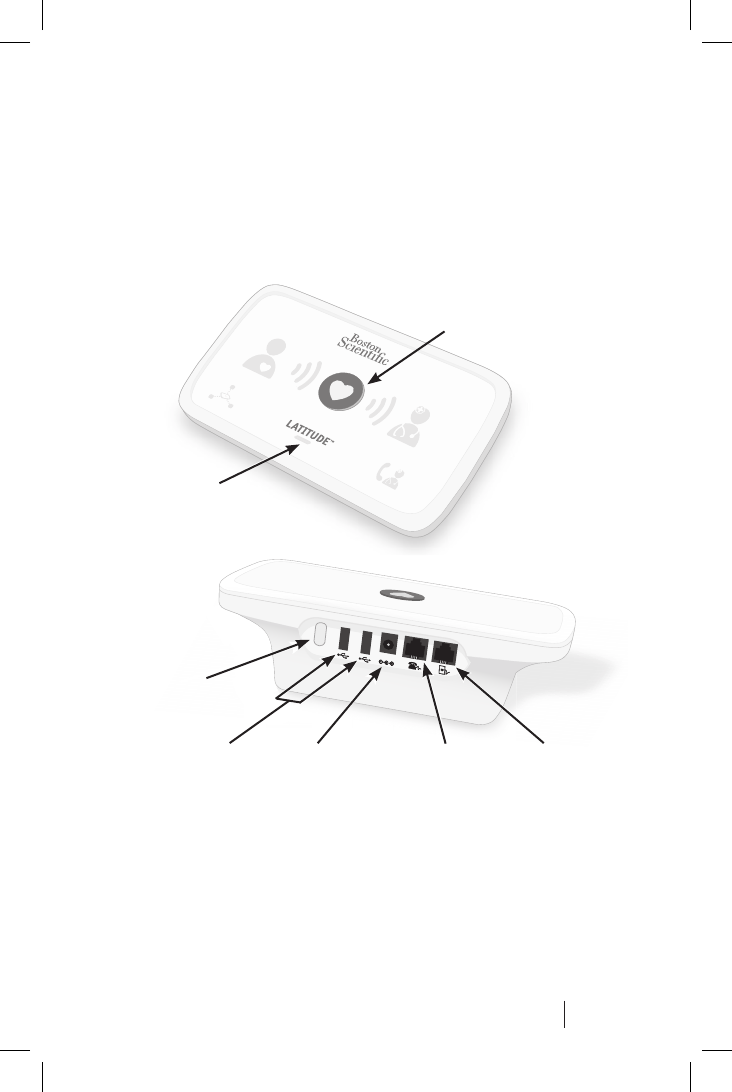
9
LATITUDE® Communicator Patient Manual
Identifying Buttons, Connectors and
Indicators
Figure 1 and Figure 2 show the buttons, indicators and
connectors on the front and back of the Communicator.
Refer to “Indicator Descriptions” on page 19 for a
description of each indicator.
Figure 1. Buttons and connectors
To telephone
wall jack
To telephone
(optional)
Power
input
Status
Button
USB ports
(wireless
connection to
sensors)
Heart Button
LATITUDE
Indicator
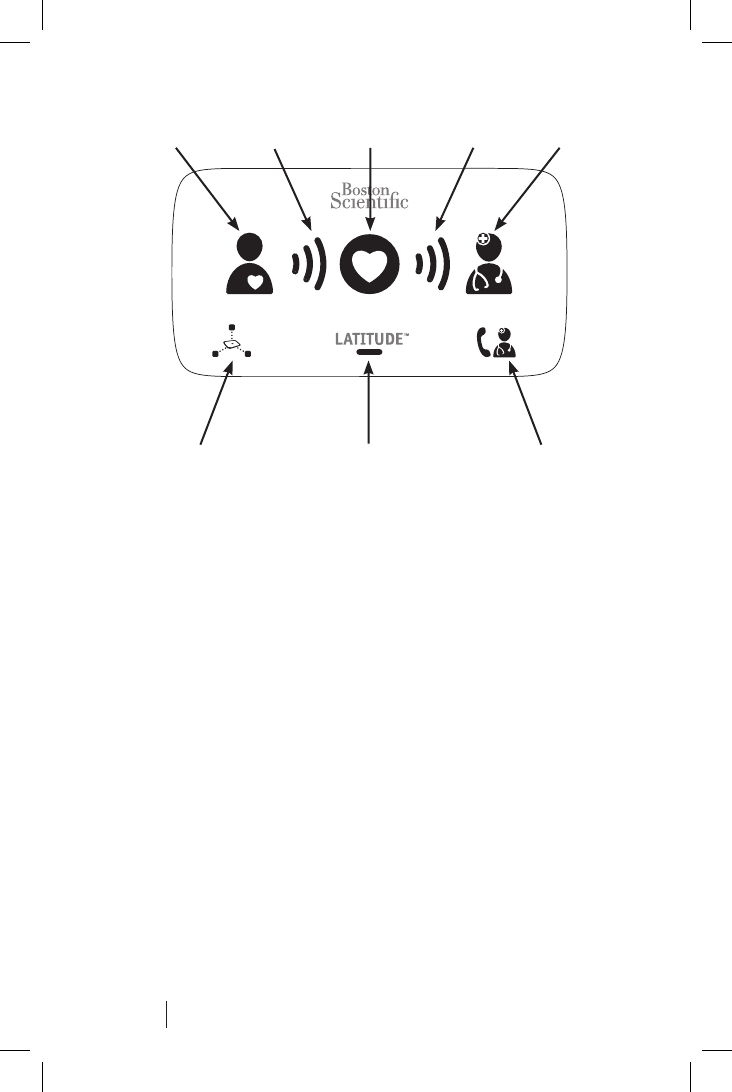
10 LATITUDE® Communicator Patient Manual
How to Connect Your Communicator
Complete the following steps to connect and install
the Communicator. There are two different procedures
depending on whether you use a standard telephone
line or the LATITUDE Cellular Data Plan:
• Connections When Using a Telephone (page 11)
• Connections for the LATITUDE Cellular Data Plan
(page 14)
These instructions also appear in the Communicator
installation guide.
NOTE: If you have DSL Internet service, you may
need to use a DSL lter between the wall phone
jack and the Communicator. Refer to “DSL Internet
Service” on page 48.
Figure 2. Indicators
Heart
Button
Sending
Waves
Collecting
Waves
Patient
Icon
Doctor
Icon
LATITUDE
Indicator
Sensor
Reading
Icon
Call Doctor
Icon
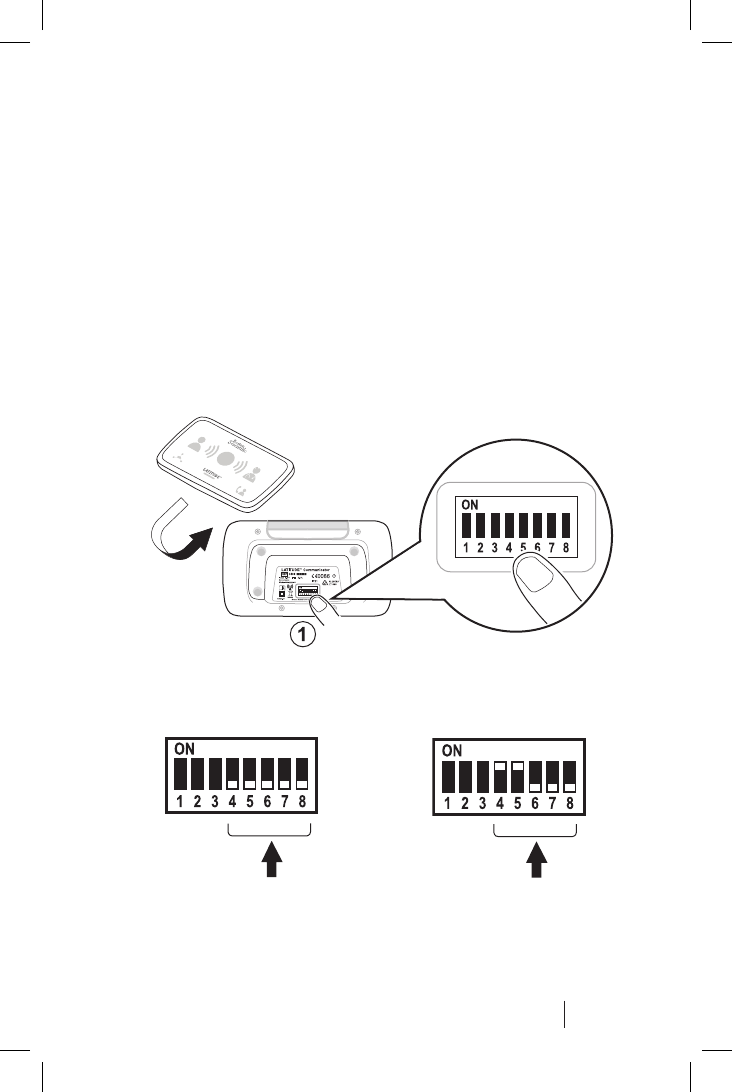
11
LATITUDE® Communicator Patient Manual
Connections When Using a Telephone
Complete the following steps to setup the
Communicator.
1. Set switches 4 through 8 on the bottom of the
Communicator to match your country as shown
in Figure 3. If you are in a location that requires
you to enter a dial-out number or prex to place
an external telephone call, set switches 1, 2, and
3. Refer to “Setting Switches for PBX or Dial-out
Numbers” on page 52.
Figure 3. Switch settings
United States,
Puerto Rico
Canada
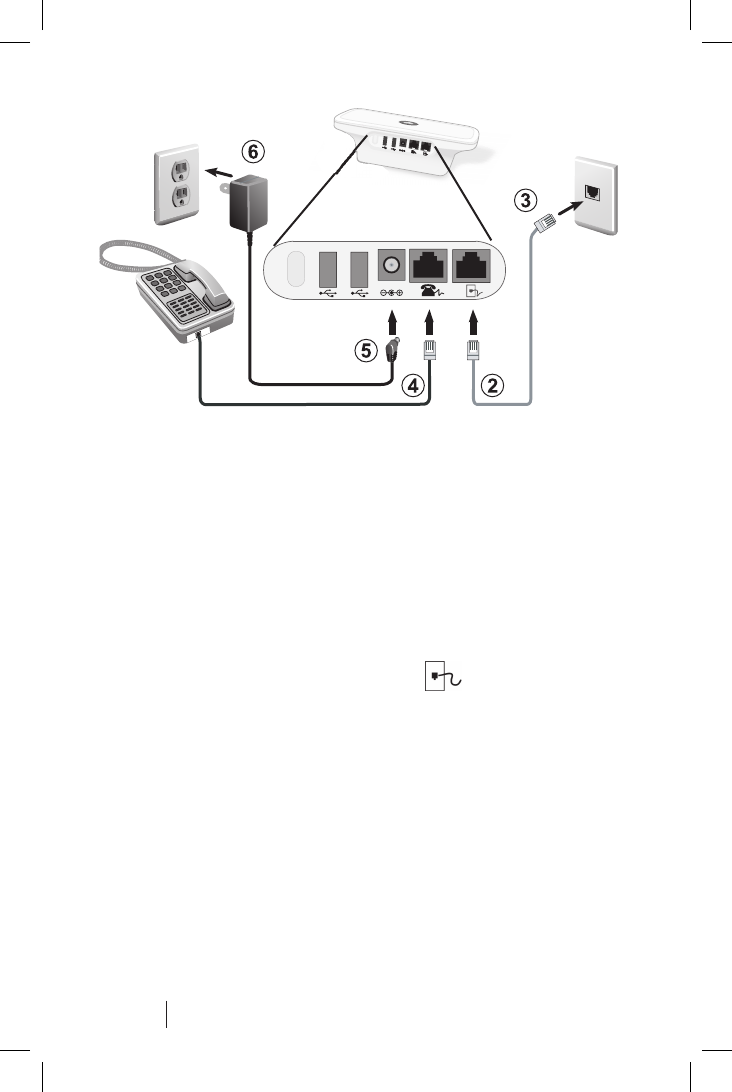
12 LATITUDE® Communicator Patient Manual
Your Communicator and a telephone can share the
same telephone wall jack. However, they can not be
used at the same time.
2. Plug one end of the Communicator telephone cord
(included) into the jack labeled .
3. Plug the other end of the cord into the telephone
jack on the wall.
NOTE: If you have DSL Internet service, you may
need to use a DSL lter between the telephone wall
jack and the Communicator. Refer to “DSL Internet
Service” on page 48.
Figure 4. Connecting to a telephone wall jack
Connecting a telephone is optional
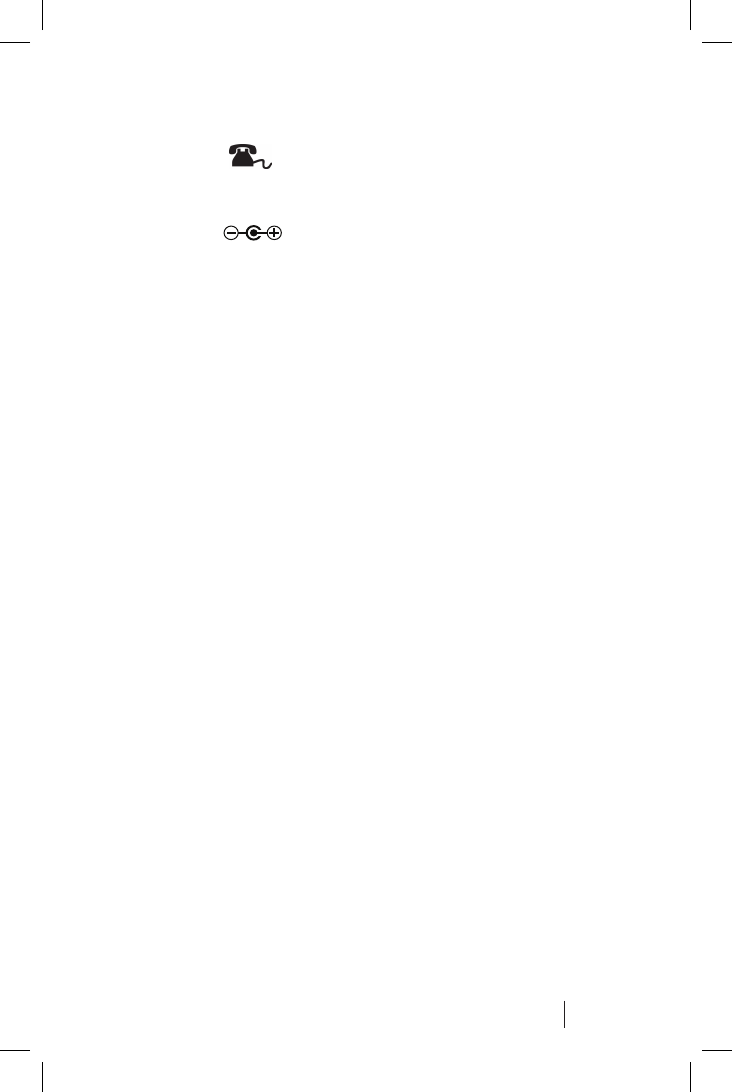
13
LATITUDE® Communicator Patient Manual
4. If you also want to use a telephone with this wall
jack, you may plug your telephone into the jack
labeled .
5. Insert the AC adapter into the jack
labeled .
6. Plug the AC adapter into an electrical outlet that is
easily accessible.
7. Make sure the LATITUDE Indicator on the front
of the Communicator is lit. The LATITUDE
Indicator ashes for up to one minute while the
Communicator starts up.
If the LATITUDE Indicator is not lit, check that both
ends of the AC adapter are plugged in rmly. Check
if the light on the AC adapter is on.
Important: Your Communicator should remain
connected to the electrical outlet and telephone wall
jack.
8. When electrical power is supplied, the
Communicator begins a startup process. The
Communicator lights all the indicators for
approximately one second to indicate all indicators
are working.
9. During the initial startup process, the Heart button
will ash with a white light. Press the ashing Heart
button, then wait until the Sending Waves light.
This is done to check if the Communicator can
interrogate your implanted device and send
your data to the LATITUDE system. Refer to the
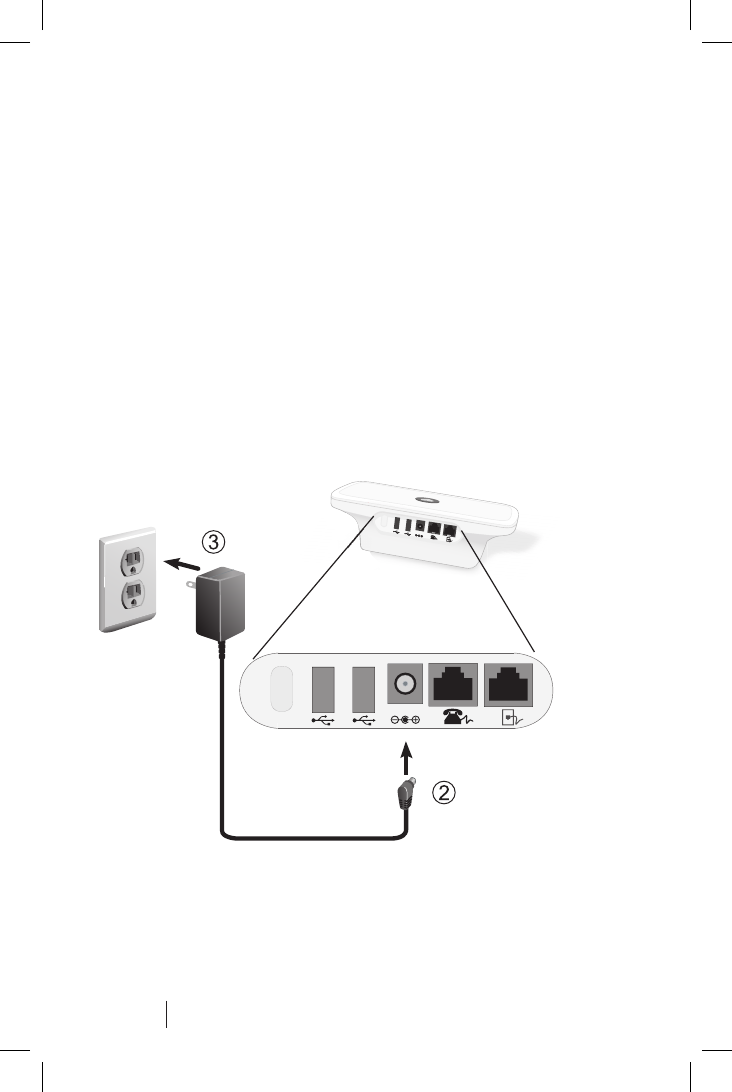
14 LATITUDE® Communicator Patient Manual
“Indicator Sequence When Using the Heart Button”
on page 17 section for more information.
Connections for the LATITUDE Cellular Data
Plan
If you have signed up for the LATITUDE Cellular Data
Plan, no telephone cords need to be attached. Refer to
“LATITUDE Cellular Data Plan” on page 41 for more
information.
1. Set switches 4 through 8 on the bottom of the
Communicator to match your country as shown in
Figure 3 on page 11.
Figure 5. Connections when using the LATITUDE®
Cellular Data Plan
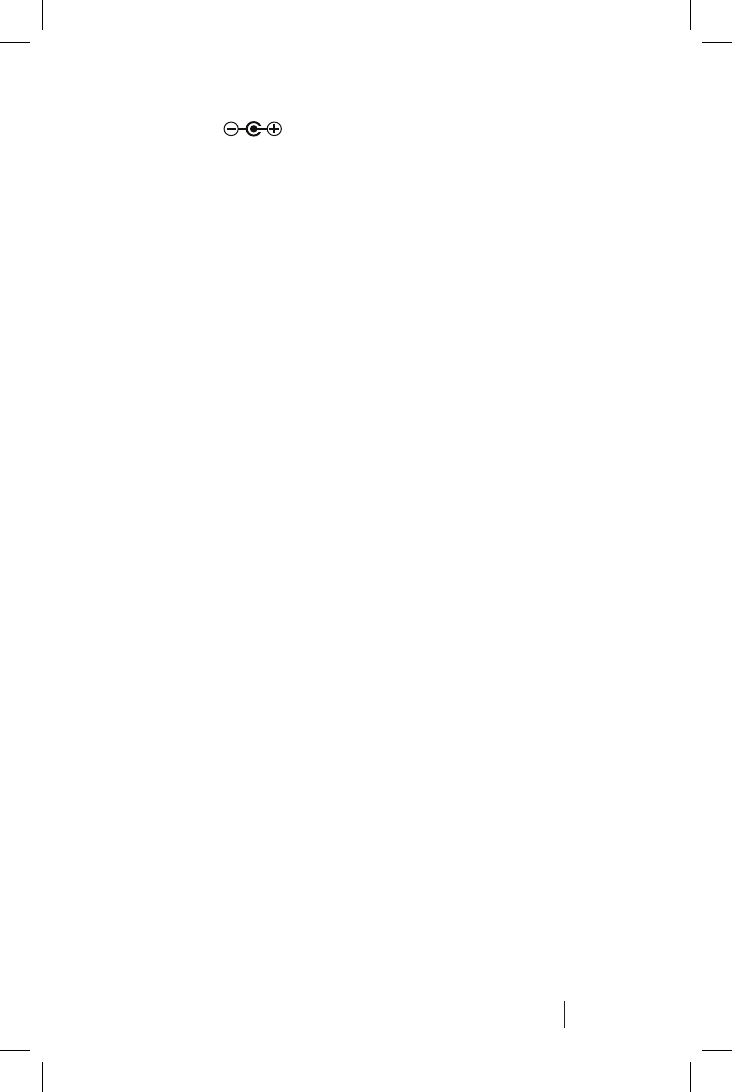
15
LATITUDE® Communicator Patient Manual
2. Insert the AC adapter into the jack
labeled .
3. Plug the AC adapter into an electrical outlet that is
easily accessible.
4. Make sure the LATITUDE Indicator on the front
of the Communicator is lit. The LATITUDE
Indicator ashes for up to one minute while the
Communicator starts up.
If the LATITUDE Indicator is not lit, check that both
ends of the AC adapter are plugged in rmly. Check
if the light on the AC adapter is on.
Important: Your Communicator should remain
connected to the electrical outlet.
5. When electrical power is supplied, the
Communicator begins a startup process. The
Communicator lights all the indicators for
approximately one second to indicate all indicators
are working.
6. During the initial startup process, the Heart button
will ash with a white light. Press the ashing Heart
button, then wait until the Sending Waves light.
This is done to check if the Communicator can
interrogate your implanted device and send your
data to the LATITUDE system. Refer to “Indicator
Sequence When Using the Heart Button” on
page 17 for more information.
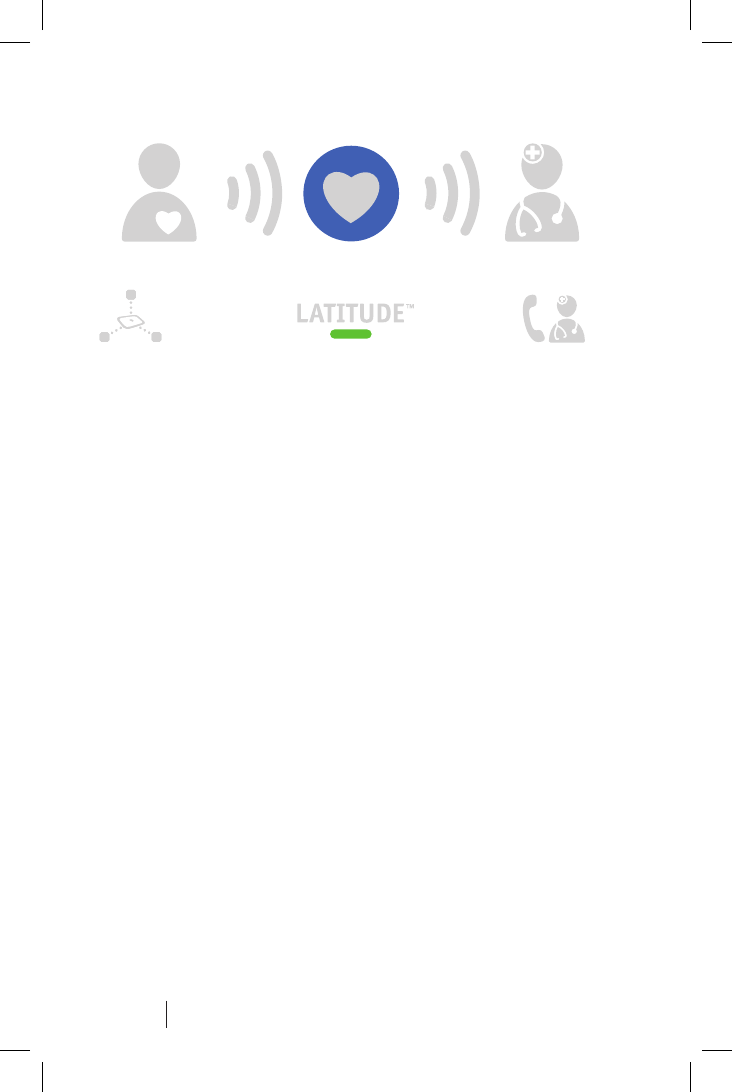
16 LATITUDE® Communicator Patient Manual
Normal Operation of the Communicator
During normal operation, only the LATITUDE indicator
will be lit (green). The Communicator automatically
interrogates your implanted device on a regular
schedule that is set by your health care provider.
Daily device checks are also performed automatically.
None of the Communicator indicators will light during
a scheduled interrogation or daily device check. They
will light when you use the Heart button as described in
“Indicator Sequence When Using the Heart Button” on
page 17.
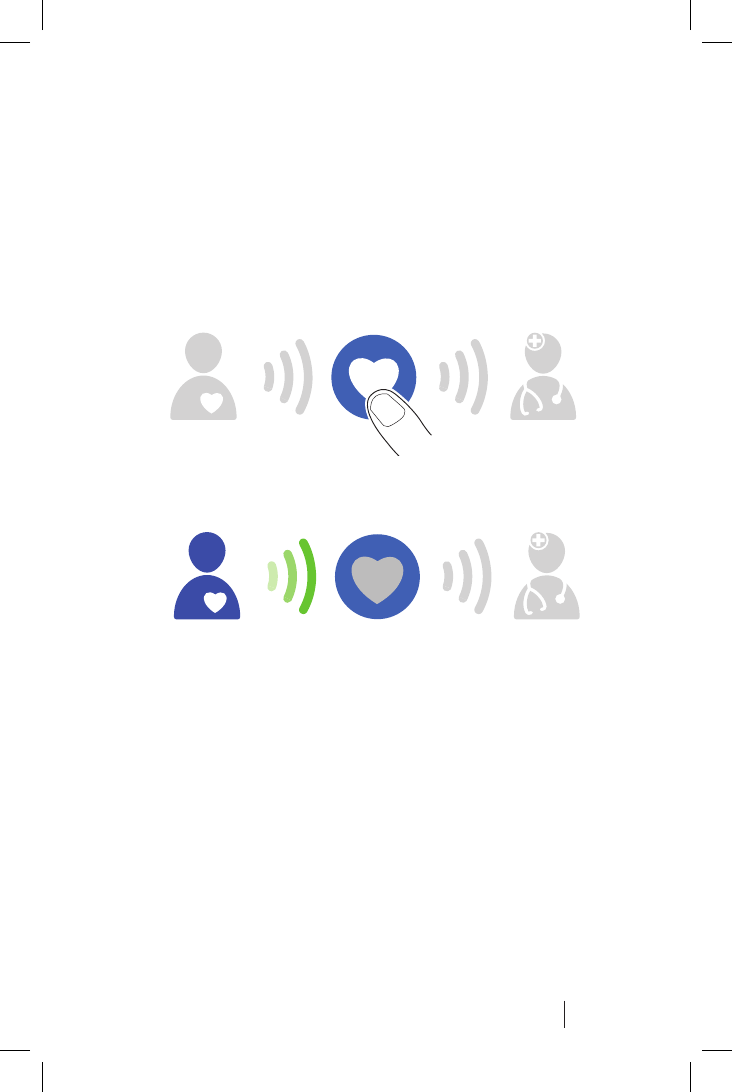
17
LATITUDE® Communicator Patient Manual
Indicator Sequence When Using the
Heart Button
This section describes how the indicators will light after
you press the Heart button. The Communicator
interrogates your implanted device and then sends your
data to the LATITUDE system. More detailed
information describing the colors and purpose of all the
indicators is provided later in the manual.
The Communicator begins interrogating your implanted
device after the Heart button is pressed.
The Patient icon lights blue. The Collecting Waves light
green in sequence and repeat while the Communicator
interrogates your device.
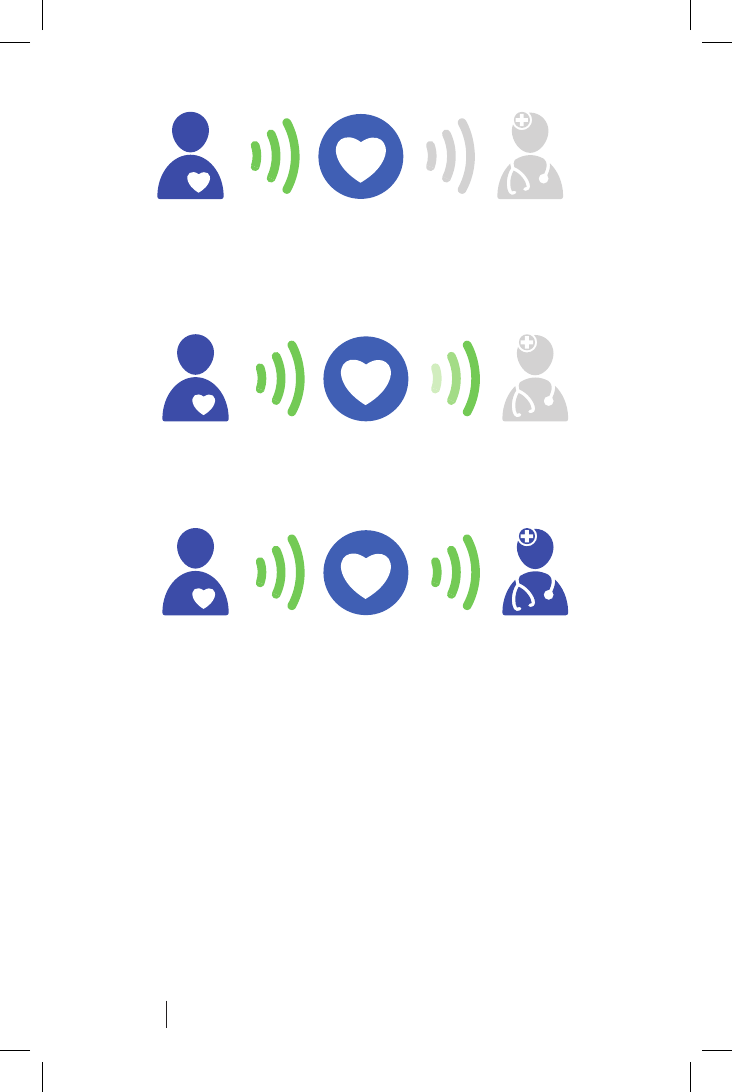
18 LATITUDE® Communicator Patient Manual
All three Collecting Waves will light green. The Heart
button lights white indicating the interrogation was
successful.
The Sending Waves light green in sequence and
repeat while the Communicator places a call and starts
sending your data to the LATITUDE system.
The Doctor icon lights blue indicating the
Communicator successfully sent your data to the
LATITUDE system. All the indicators shown stay lit
for two minutes to indicate the entire process was
successful.
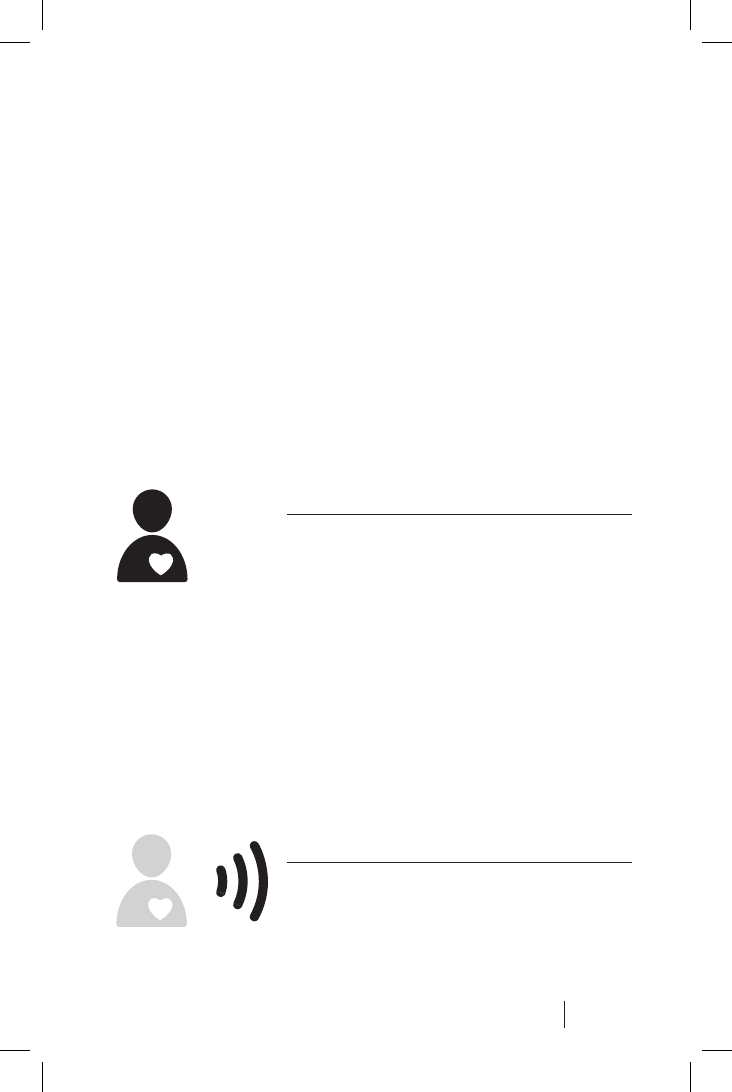
19
LATITUDE® Communicator Patient Manual
Indicator Descriptions
The indicators will light to indicate the Communicator’s
progress when:
• Manually interrogating your implanted device
• Connecting and sending your device information to
the LATITUDE system
• Collecting a measurement from a prescribed weight
scale or blood pressure monitor
One or more indicators may light or ash a different
color to indicate some type of action may need to be
taken. Refer to “Troubleshooting Errors” on page 27.
Patient Icon
Indicates the Communicator is
interrogating (collecting data from)
your implanted device.
• Lights blue when the Heart
button is pressed and an
interrogation has started.
The Patient icon stays lit for
2 minutes after a successful
interrogation.
Collecting Waves
Indicates the Communicator is
collecting data from your implanted
device or an error occurred while
collecting data.
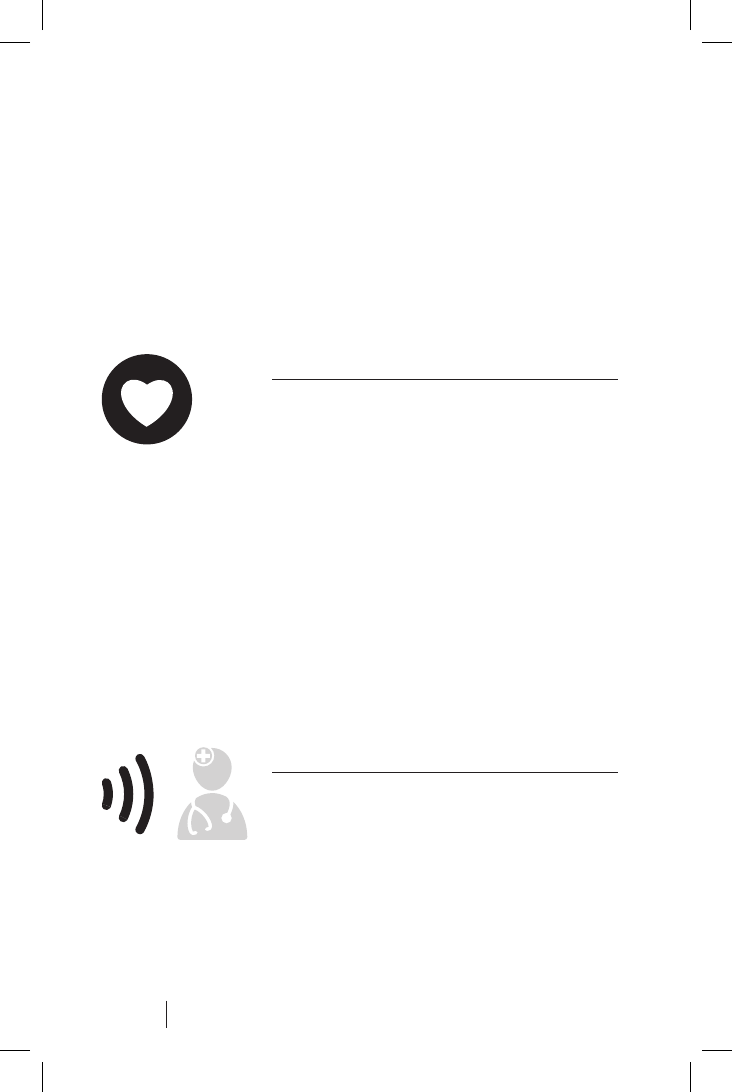
20 LATITUDE® Communicator Patient Manual
• These waves light green
in sequence and repeat,
indicating the Communicator
is interrogating your implanted
device.
• All three waves light green
for 2 minutes to indicate the
interrogation was successful.
Heart Button
The Heart button ashes with
a white light if you need to
complete a previously scheduled
interrogation. The Heart button
lights a solid white to indicate the
interrogation is complete.
The Heart button can also be
used to manually initiate an
interrogation of your implanted
device. Refer to “Interrogating
Your Implanted Device” on
page 43 before using this
button.
Sending Waves
Indicates the Communicator is
connecting to the LATITUDE
system.
• These waves light green in
sequence and repeat, indicating
a connection to LATITUDE is in
progress.
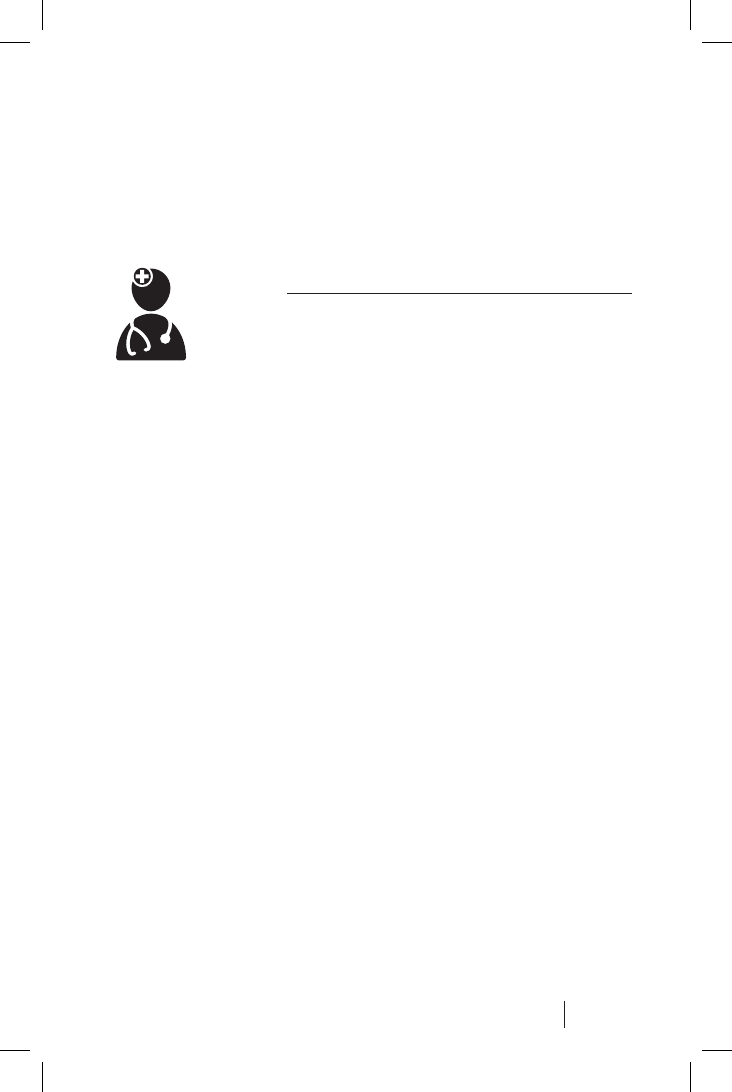
21
LATITUDE® Communicator Patient Manual
• All three waves light green
for 2 minutes to indicate the
connection to the LATITUDE
system was successful and any
collected device data was sent.
Doctor Icon
Lights blue to indicate the
Communicator has successfully
connected to the LATITUDE
system. The Communicator sends
any data from your implanted
device, scale, or blood pressure
monitor that is stored in the
Communicator’s memory.
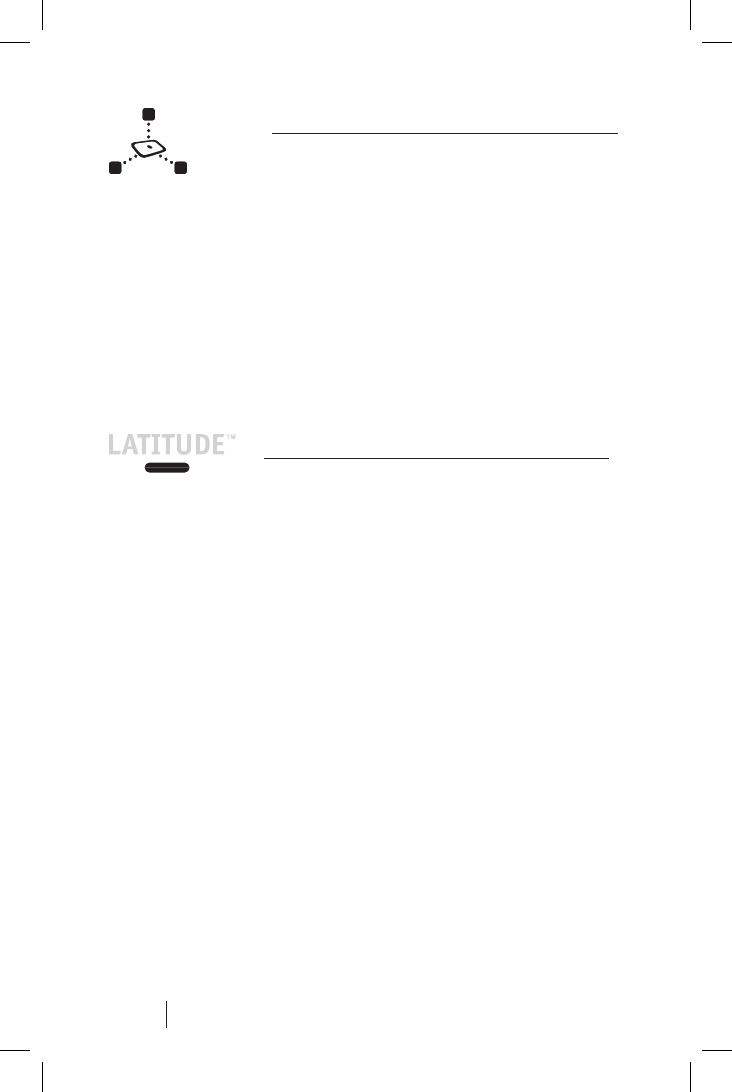
22 LATITUDE® Communicator Patient Manual
Sensor Reading Icon
Indicates the Communicator has
successfully communicated with a
prescribed weight scale or blood
pressure monitor.
• Flashes green ve times and
remains lit for 5 minutes to
indicate the Communicator
successfully received a weight
or blood pressure measurement.
LATITUDE Indicator
Indicates the Communicator is
connected to electrical power. It
also indicates if the Communicator
startup process is being performed
or if the Communicator is ready to
use.
• Lights green to indicate the
Communicator is connected to
electrical power and is ready to
use.
• Flashes yellow during the
startup process.
The LATITUDE indicator could
ash yellow for an extended
period. This indicates that new
software was downloaded from
LATITUDE and is being installed
on the Communicator.
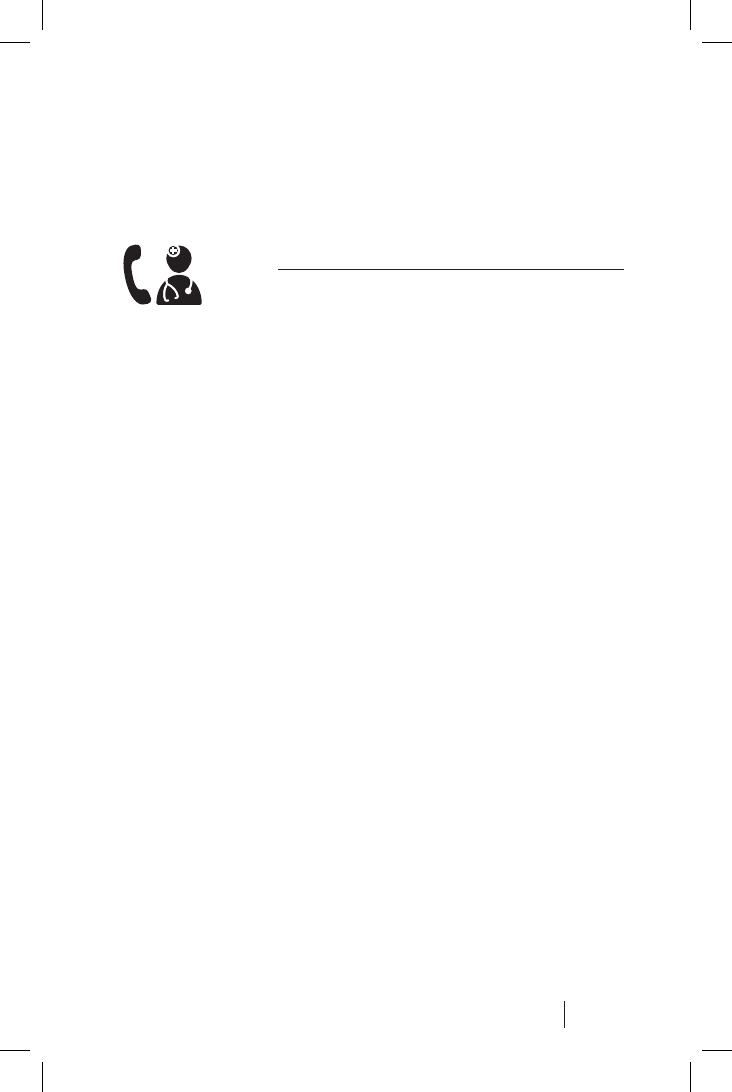
23
LATITUDE® Communicator Patient Manual
• If an error exists, the LATITUDE
Indicator stays yellow for 60
minutes or until the error is
resolved.
Call Doctor Icon
The Call Doctor icon lights yellow
or red to indicate a problem
was detected that should be
communicated to your health
care provider. Refer to the error
description in “Troubleshooting
Errors” on page 27.
A red light has higher priority than
a yellow light. If an error for each
color occurs at the same time, only
the red error indicator is displayed.
The Call Doctor icon ashes yellow
briey after the Communicator
is plugged into electrical power.
The light turns off after the
Communicator successfully
completes the startup process.
If the startup process does not
complete, it lights solid yellow.
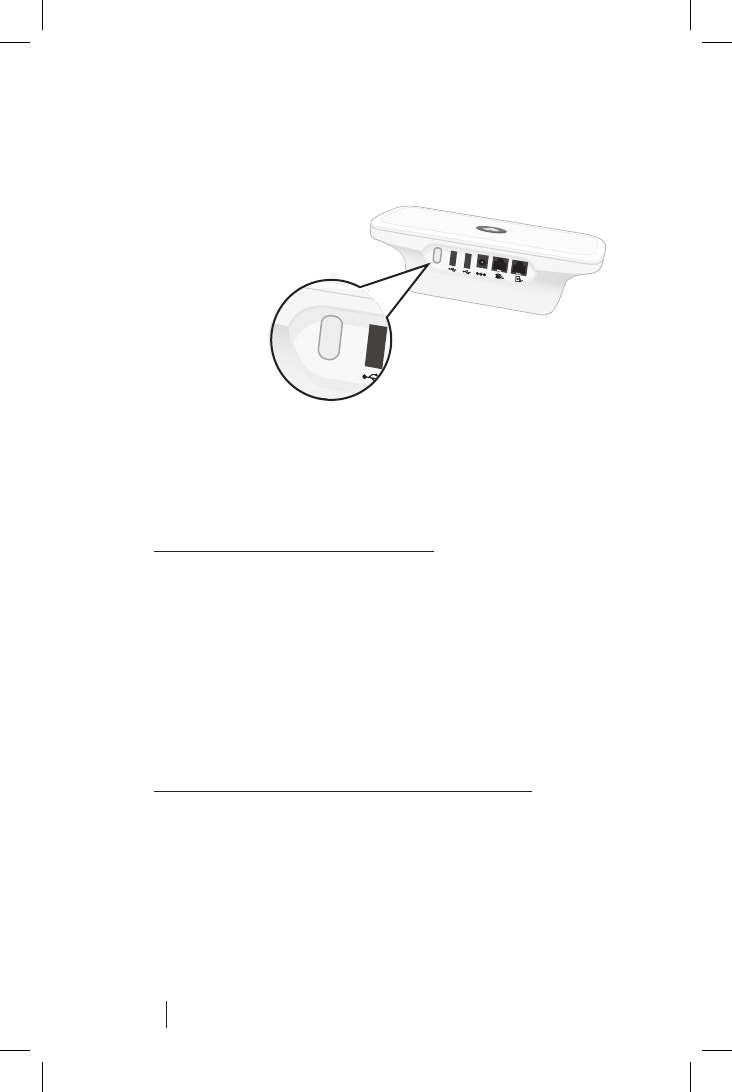
24 LATITUDE® Communicator Patient Manual
Status Button
The Status Button is located on the back of the
Communicator as shown in Figure 6.
The Status button performs one the following actions
depending on how long the button is pressed:
• Press for less than 3 seconds: The Communicator
indicators will light to display:
• The status of the last interrogation
• The status of the last connection to the
LATITUDE system.
The indicators will light for 2 minutes. If the Call
Doctor icon was blinking, it will stop blinking and
stay lit.
• Press and hold for more than 3 seconds: The
Sending Waves light green in sequence and
repeat while the Communicator connects to the
LATITUDE system.
Figure 6. Status Button
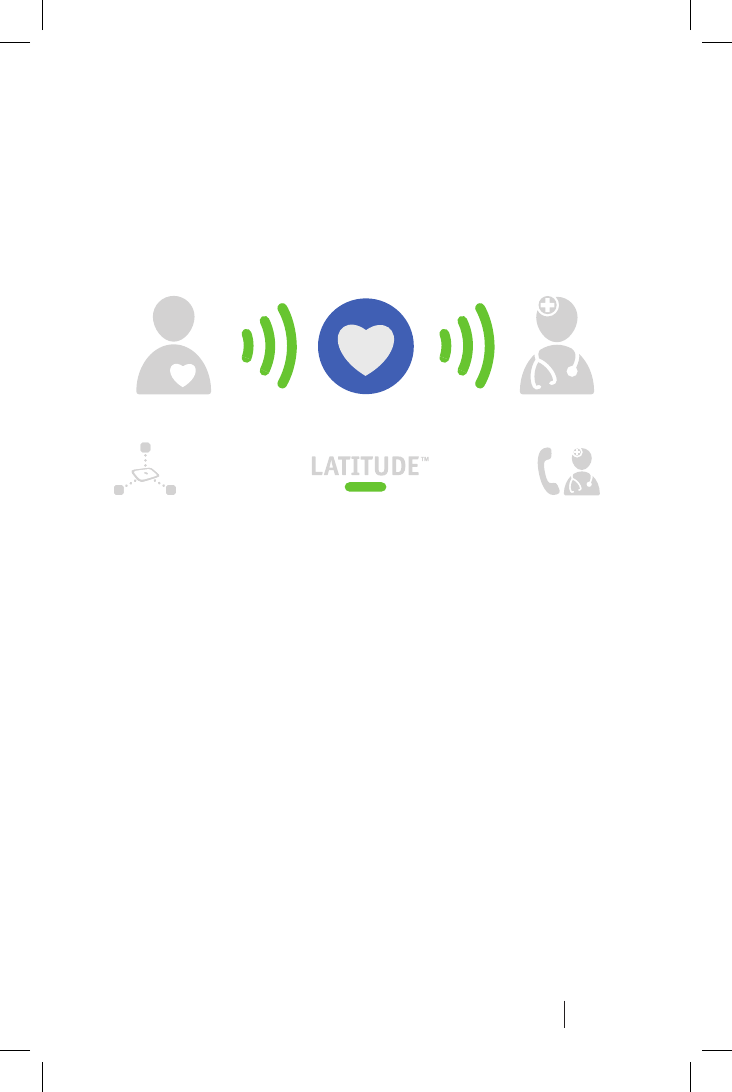
25
LATITUDE® Communicator Patient Manual
Note:
If you pressed the Heart button, the Status button
will not function until the resulting interrogation is
completed or is cancelled.
ConrmingNormalOperation
You can use the Status button to check if the
Communicator is operating normally. The above image
shows that all the Collecting and Sending Waves are
lit green, indicating that the last interrogation and the
last connection to LATITUDE system were successful.
When the waves are lit like this, you don’t need to take
any action.

26 LATITUDE® Communicator Patient Manual
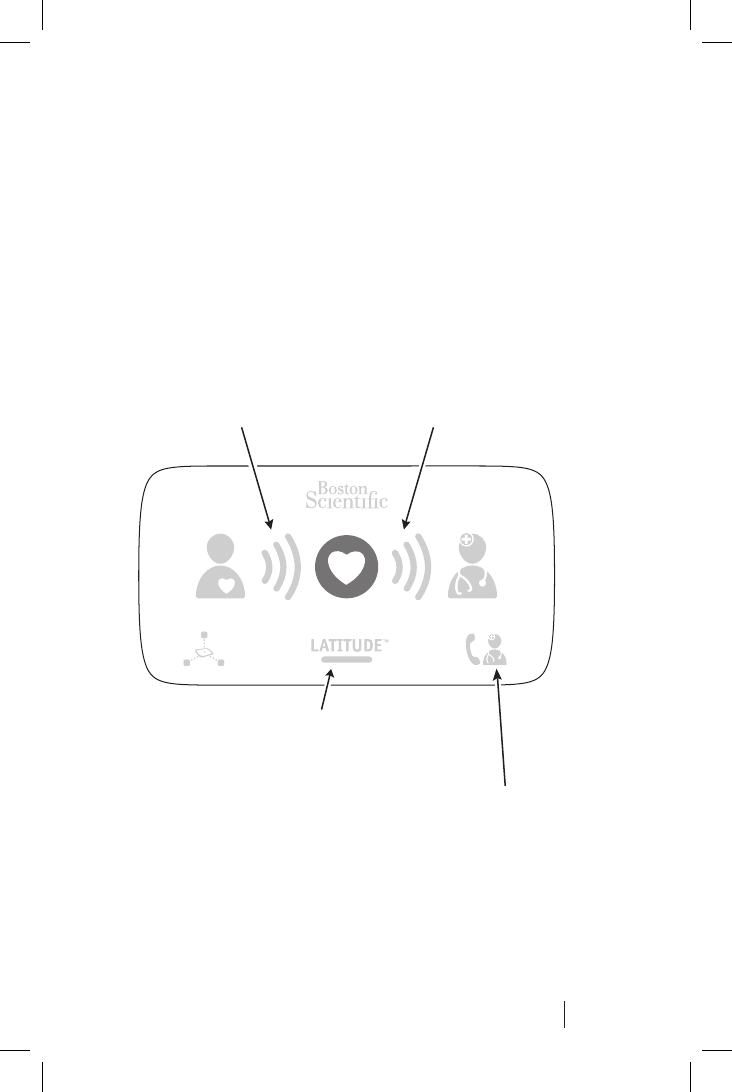
27
LATITUDE® Communicator Patient Manual
Troubleshooting Errors
One or more of the indicators on the front of the
Communicator may light or ash to indicate some type
of Communicator, phone communication, or LATITUDE
system error. A general description of the types of
errors are shown in Figure 7. A description of each error
is provided on the following pages along with
suggested actions to resolve each error.
Yellow Collecting Waves
Indicate errors collecting
information from your
implanted device
Yellow Sending Waves
Indicate errors sending
information to the LATITUDE
system
Call Doctor Icon
Call your doctor when lit
LATITUDE Indicator
Green light indicates power is on
Yellow light indicates an error
Figure 7. Types of errors
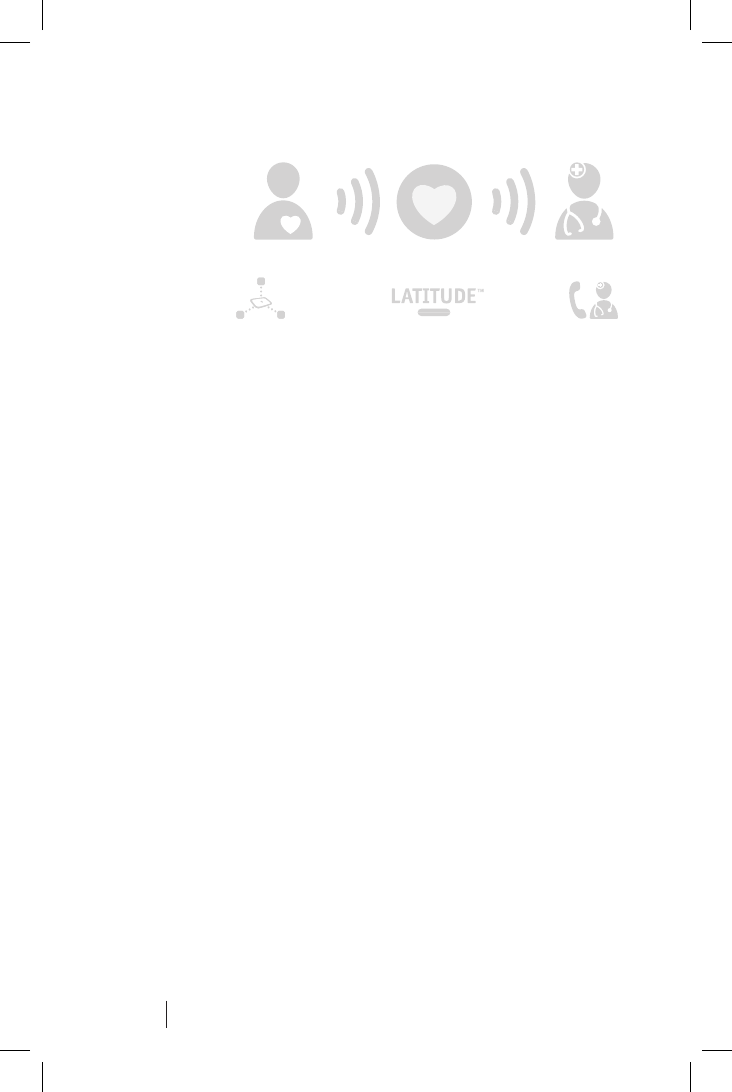
28 LATITUDE® Communicator Patient Manual
No Indicators are Lit
Description: The Communicator is not connected to
electric power or it is not functioning.
Action: • If the LATITUDE indicator is not
lit, check that both ends of the AC
adapter are plugged in rmly.
• Check if the light on the AC adapter is
on.
• If the Communicator is plugged into
electric power and the light on the AC
adapter is on, contact your health care
provider.
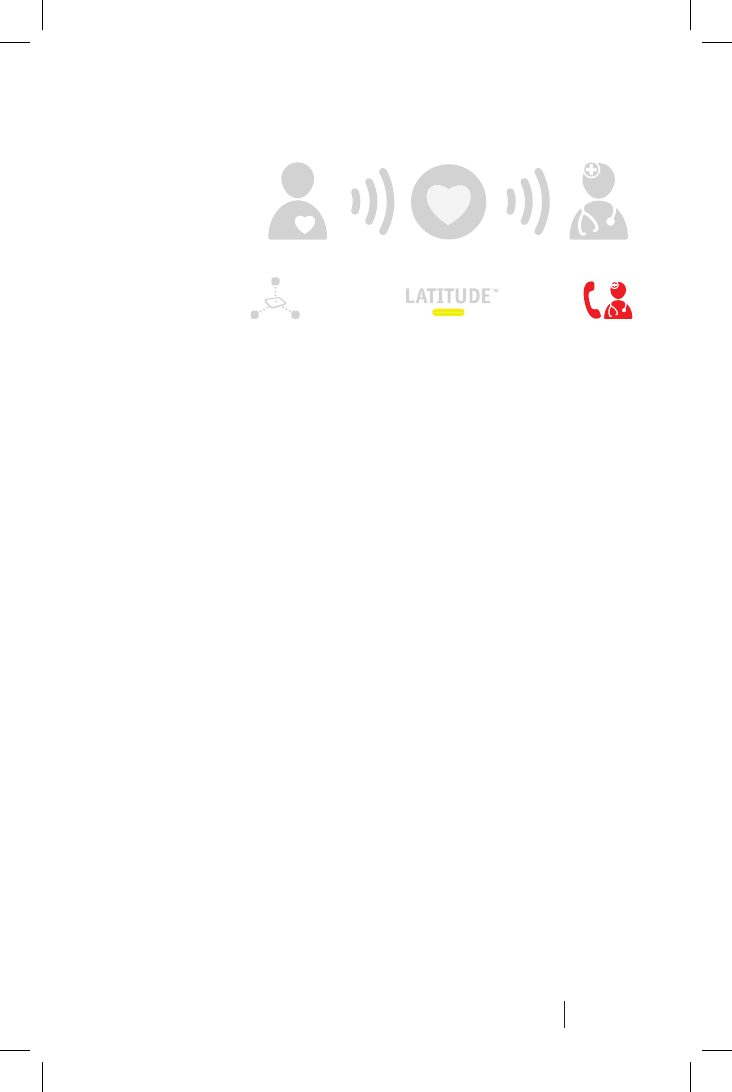
29
LATITUDE® Communicator Patient Manual
Call Doctor Icon is Red and LATITUDE Icon is
Yellow
Description: The Call Doctor icon is red and the
LATITUDE icon is yellow.
The Call Doctor icon will stay lit until the
problem is resolved.
If the Call Doctor icon is ashing,
it will light solid after the error is
acknowledged (by pressing the Status
button).
A potential problem with your implanted
device was detected.
The Communicator is monitoring
your device but it cannot send any
information collected from your
implanted device to the LATITUDE
system.
Action: Your immediate response is required.
Call your health care provider.
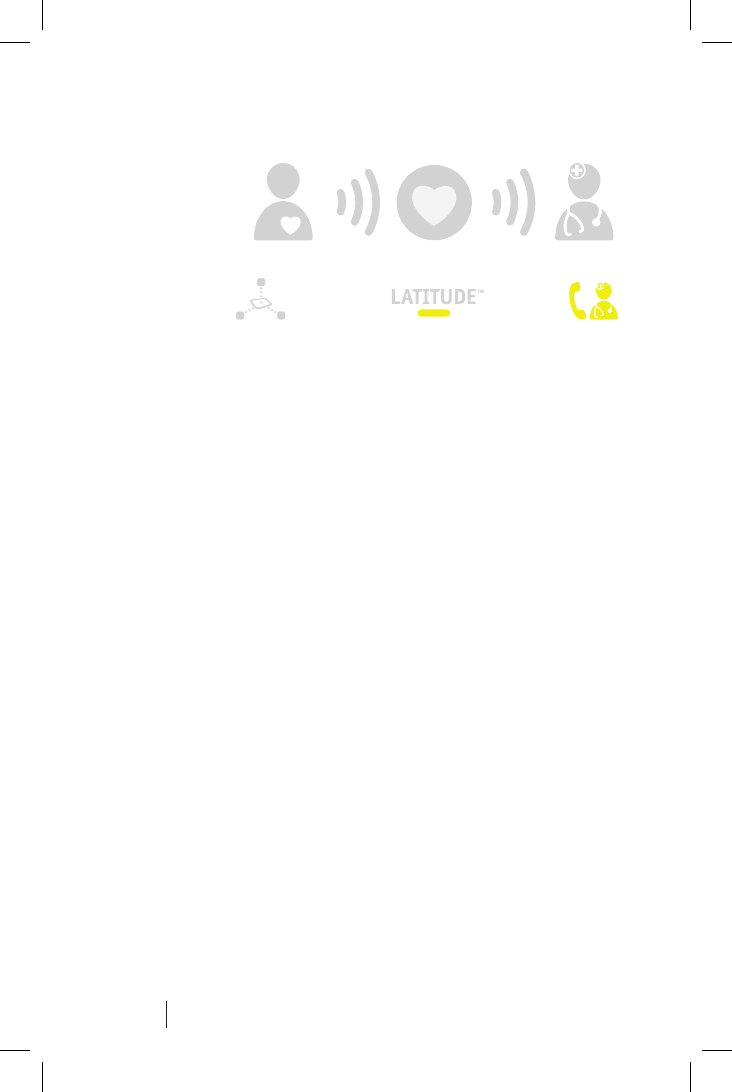
30 LATITUDE® Communicator Patient Manual
Call Doctor Icon is Yellow and LATITUDE Icon is
Yellow
Description: The Call Doctor icon is yellow and the
LATITUDE icon is yellow.
The Call Doctor icon will stay lit until the
problem is resolved.
If the Call Doctor icon is ashing,
it will light solid after the error is
acknowledged (by pressing the Status
button).
Indicates one of the following errors:
• Your Communicator is currently
unable to monitor your implanted
device.
• Monitoring of your implanted
device was suspended through the
LATITUDE system.
Action: Call your health care provider.
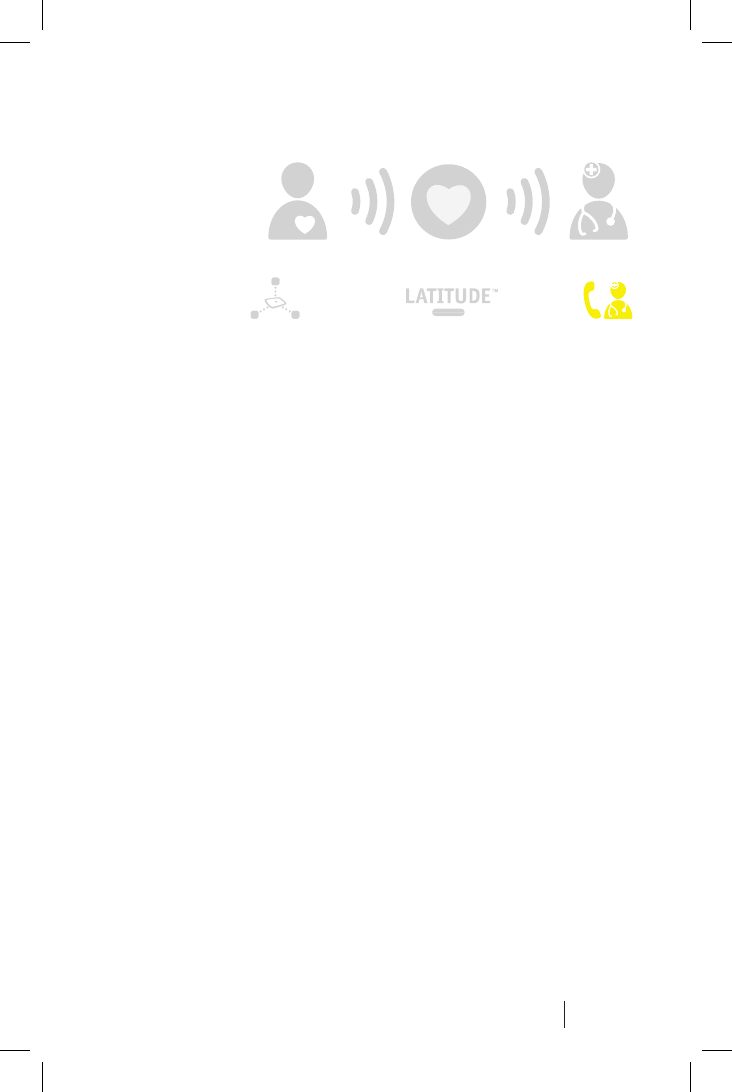
31
LATITUDE® Communicator Patient Manual
Call Doctor Icon Lit
Description: Only the Call Doctor icon is lit yellow
(the LATITUDE Indicator is not lit). This
indicates your Communicator may not
be working properly.
Action: Press the Status button and check
that the Call Doctor icon lights a solid
yellow and does not ash. Also check
that the LATITUDE icon still does not
light. If only the Call Doctor icon lights
a solid yellow, you may need to get a
replacement Communicator. Call your
health care provider.

32 LATITUDE® Communicator Patient Manual
Wave Indicator Colors
The Wave indicators will light yellow to indicate an
error. Wave errors stay lit for 60 minutes, or until the
cause of the error is resolved. Please respond to error
indicators as soon as possible.
• Green. All three Collecting Waves will light
green for 2 minutes to indicate a successful
interrogation of your implanted device. All three
Sending Waves will light green for 2 minutes to
indicate the Communicator successfully sent your
information to the LATITUDE system.
• Yellow. One or more of the Wave indicators will
light yellow to indicate some type of error as
described below. The Waves ash for 60 minutes
unless the error is resolved sooner. After 60
minutes, all Wave lights are turned off and the
LATITUDE icon is lit green, even if the problem
was not resolved.
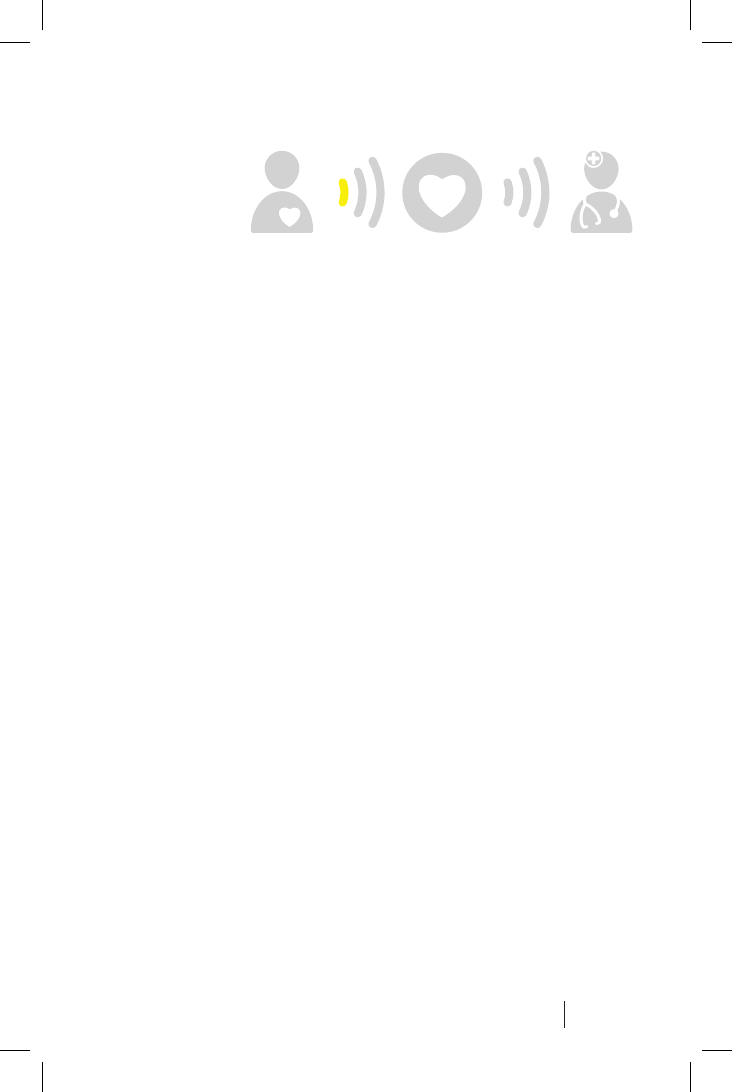
33
LATITUDE® Communicator Patient Manual
One Yellow Collecting Wave
Description: The Communicator was unable to
start an interrogation of your implanted
device or your implanted device is now
out of range.
Action: • Ensure the Communicator is optimally
placed as described in “Where
to Place Your Communicator” on
page 7.
• Face the Communicator. Sit directly
in front of the Communicator. Make
sure you are within 10 ft (3 m) of the
Communicator.
• Move any wireless electronic products
(such as cordless phones or baby
monitors) that are within 11 ft (3.3 m)
of the Communicator.
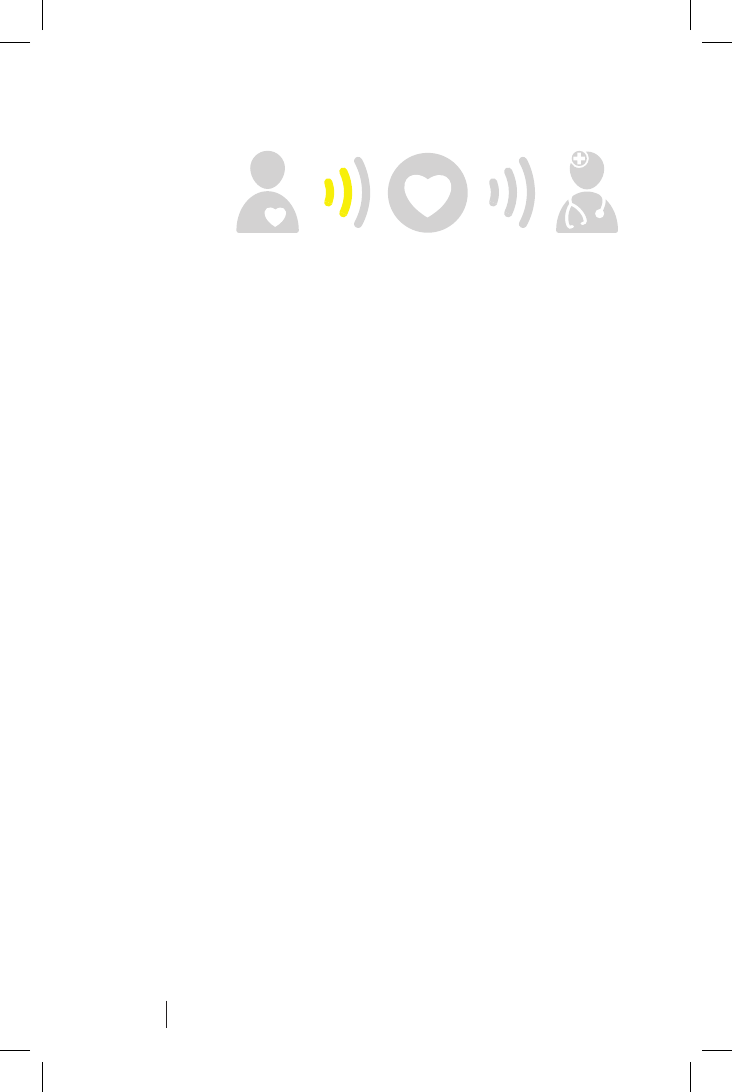
34 LATITUDE® Communicator Patient Manual
Two Yellow Collecting Waves
Description: The Communicator was unable to
establish wireless communication with
your implanted device due to interference
from other wireless electronic devices
.
The Communicator started but was not
able to complete the interrogation within
the time allowed.
Action: • Ensure the Communicator is optimally
placed as described in “Where to Place
Your Communicator” on page 7.
• Face the Communicator. Sit directly
in front of the Communicator. Make
sure you are within 10 ft (3 m) of the
Communicator.
• Remain still until the interrogation is
complete. Do not move away from the
Communicator.
• Move any wireless electronic products
(such as cordless phones or baby
monitors) that are within 11 ft (3.3 m) of
the Communicator.
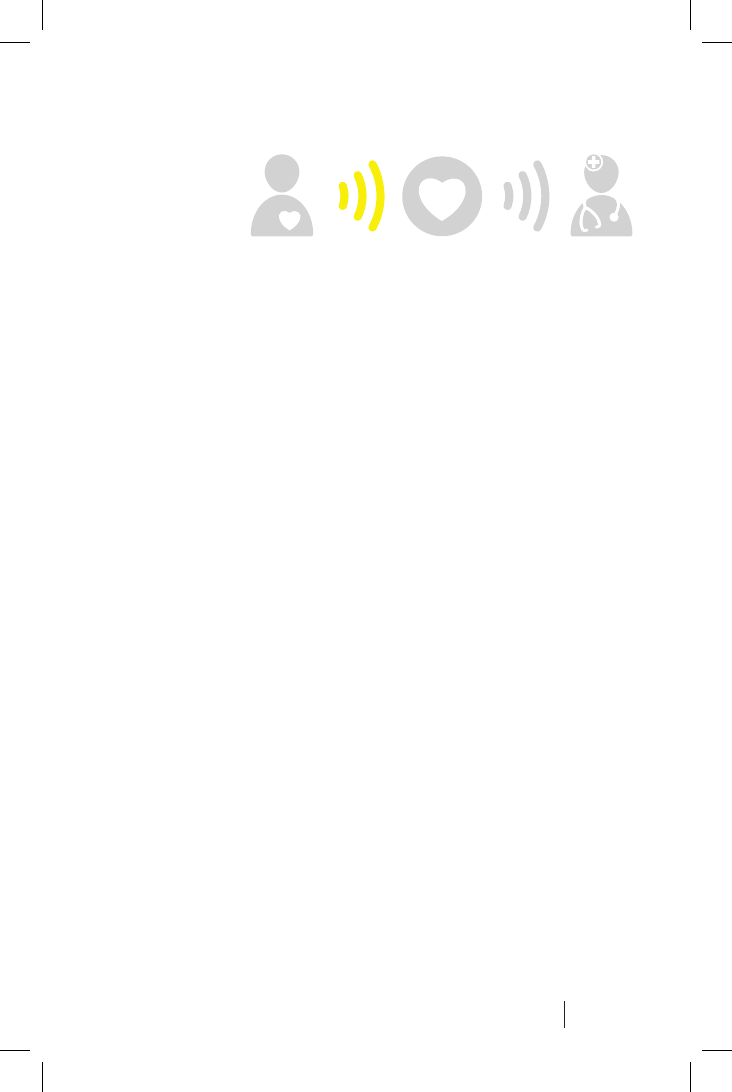
35
LATITUDE® Communicator Patient Manual
Three Yellow Collecting Waves
Description: Any of the following reasons could cause
this error:
• You may have exceeded your weekly
interrogation limit, so you are not able
to use the Heart button.
• The Communicator was unable to
establish wireless communication
with your implanted device due to
interference from another person’s
implanted device.
Action: • If you are planning to interrogate
your device, wait 10 minutes. Then
try pressing the Heart button again to
initiate the interrogation.
• Do not press the Heart button while the
interrogation is in progress unless you
intend to stop the interrogation.
• Contact your health care provider.
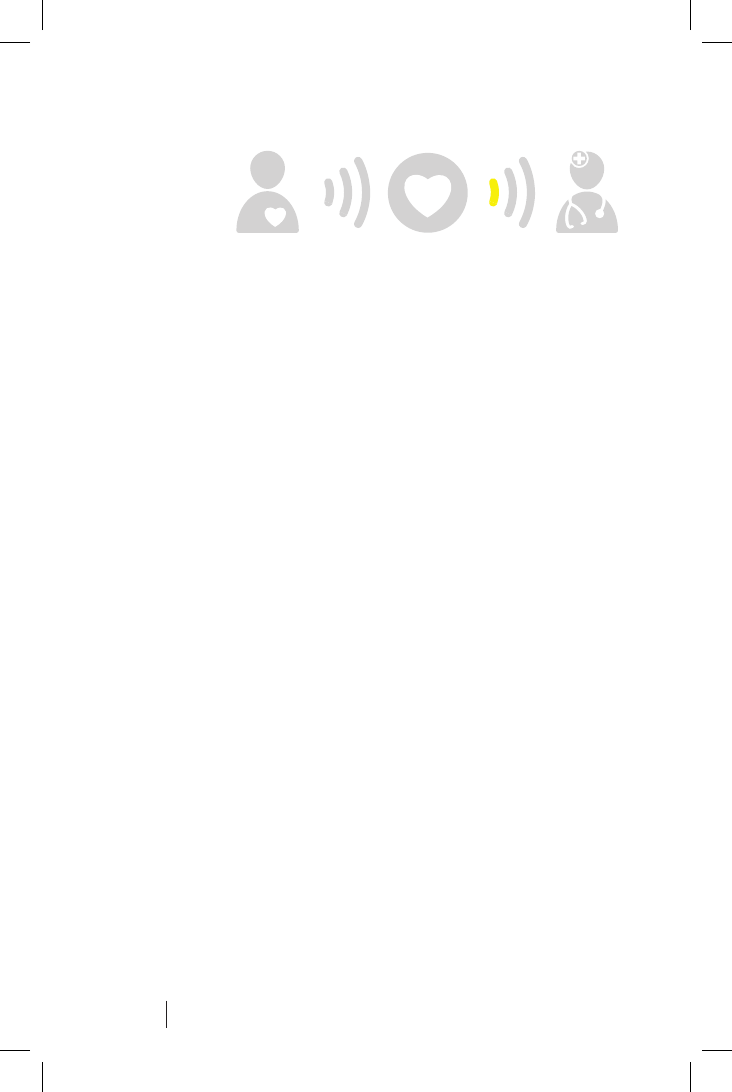
36 LATITUDE® Communicator Patient Manual
One Yellow Sending Wave
Description: The Communicator was not able to
make a connection to the LATITUDE
system for one of the following reasons:
• No dial tone was detected when
attempting to use the telephone line.
• No cellular providers were detected
when attempting to connect using the
LATITUDE Cellular Data Plan.
Action: • If the Communicator will use a
telephone line, check that the
telephone cord provided with the
Communicator is plugged in tightly
to a telephone wall jack and the
Communicator.
• If a telephone is connected to the
Communicator, pick the telephone up
and check for dial tone.
• If the Communicator will use a
telephone line, check that the analog
telephone service supports the tone
dialing mode.
• If you use the LATITUDE Cellular
Data Plan, move the Communicator to
another location that may have better
cellular reception.

37
LATITUDE® Communicator Patient Manual
• After trying the above actions,
initiate a connection to LATITUDE
by pressing and holding the Status
button until the Sending Waves
light green in sequence and repeat.
All three Sending Waves should
light a constant green to indicate a
successful connection was made to
the LATITUDE system.
• Check if the Communicator can
connect to the LATITUDE system.
Refer to “Checking that the
Communicator Can Connect to
LATITUDE” on page 45.
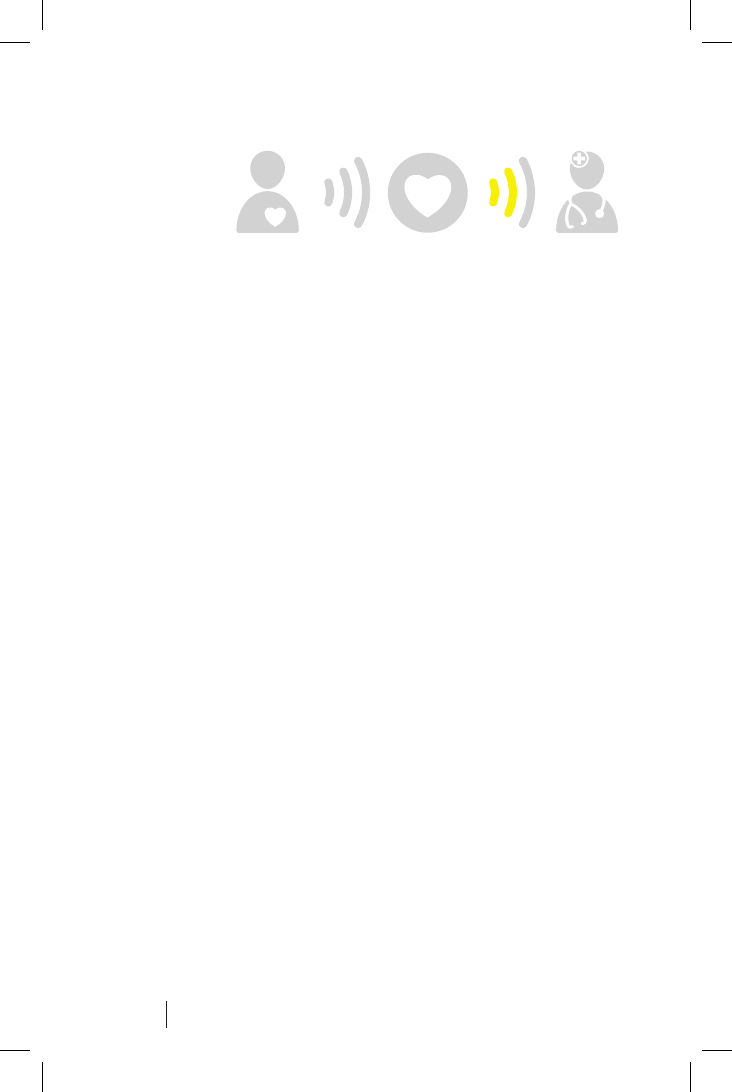
38 LATITUDE® Communicator Patient Manual
Two Yellow Sending Waves
Description: An attempt to connect to the LATITUDE
system failed.
The Communicator established a
connection using the LATITUDE Cellular
Data Plan, but the connection was
dropped or the signal was lost
.
Action: Check if the Communicator can connect
to the LATITUDE system. Refer to
“Checking that the Communicator Can
Connect to LATITUDE” on page 45.
If using a telephone line:
• If you use a telephone, make sure
your telephone is not being used at
this time.
• Remove any splitters between the
Communicator and the telephone wall
jack.
• Ensure you are using a DSL lter
between the Communicator and the
telephone wall jack, if you have DSL
internet service.

39
LATITUDE® Communicator Patient Manual
• Check that the switches on the bottom
of the Communicator are set correctly
for your country and if you need to dial
a number to get an outside line. Refer
to “Setting Switches for Your Country”
on page 51 and “Setting Switches
for PBX or Dial-out Numbers” on
page 52.
If using the LATITUDE Cellular Data
Plan:
• Move the Communicator to another
location that may provide a stronger
cellular signal.
• If other locations do not work after
trying another connection (see below),
try plugging the Communicator into an
active telephone wall jack.
To verify troubleshooting was
successful:
• Press and hold the Status button
until the Sending Waves light green
in sequence and repeat. If the
connection is successful, all three
Sending Waves will light green for 2
minutes.
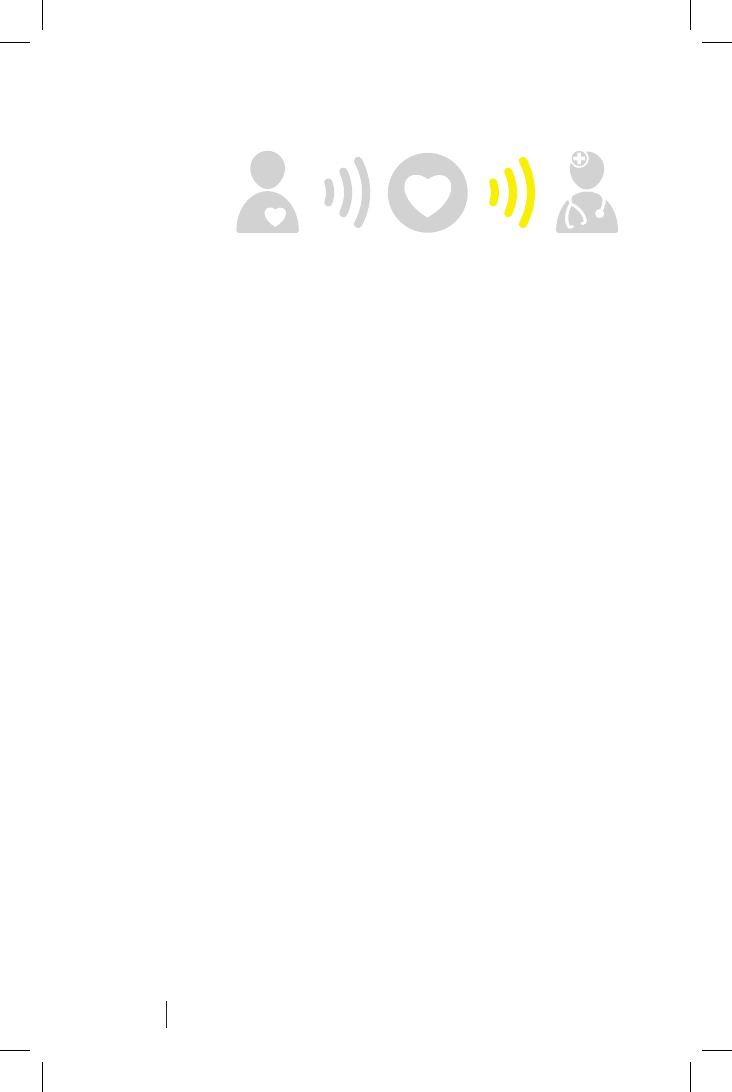
40 LATITUDE® Communicator Patient Manual
Three Yellow Sending Waves
Description: The Communicator was able to
establish a connection, but no
information reached the LATITUDE
system.
A telephone, answering machine,
computer or other device may be using
or attempted to use the telephone line
.
Action: • Check if the Communicator can
connect to the LATITUDE system.
Refer to “Checking that the
Communicator Can Connect to
LATITUDE” on page 45.
• If you see three yellow waves after
trying the above action, contact your
health care provider.

41
LATITUDE® Communicator Patient Manual
LATITUDE Cellular Data Plan
The LATITUDE Cellular Data Plan uses a cellular data
network rather than a standard telephone line to send
your implanted device data to the LATITUDE system.
The LATITUDE Cellular Data Plan is an optional
subscription service that must be activated before your
Communicator can use this service.
You need either a standard analog telephone line or
the LATITUDE Cellular Data Plan to use the LATITUDE
Patient Management system.
The LATITUDE Cellular Data Plan uses a data only
network. It does not send voice signals and it cannot be
used with your cellular phone service.
NOTE: Your Communicator is designed to use
a telephone line if it is connected to an active
telephone jack. If connected, your Communicator
will send your device data over the telephone
line even if you are subscribed to the LATITUDE
Cellular Data Plan.
Activating the LATITUDE Cellular Data Plan
Contact Patient Services at 1-866-484-3268 to
subscribe to the LATITUDE Cellular Data Plan. There
is a cost for this service unless your clinic has made
other arrangements. An activated plan only works with
your Communicator. If a replacement Communicator is
ever needed, contact Patient Services to update your
subscription.
Once the LATITUDE Cellular Data Plan is activated,
you can verify the connection by following the
instructions in “Checking that the Communicator Can

42 LATITUDE® Communicator Patient Manual
Connect to LATITUDE” on page 45. If you travel to
another location with your Communicator, check the
connection from that location.
Troubleshooting and Support
Subscription to the LATITUDE Cellular Data Plan
does not guarantee coverage. Actual coverage may
be affected by such things as terrain, weather, foliage,
buildings and other construction, signal strength,
customer equipment, and other factors.
The Sending Waves may light yellow if your
Communicator cannot connect through an activated
LATITUDE Cellular Data Plan. If this happens, move
the Communicator to another location and check
the connection. If this does not work, contact Patient
Services at 1-866-484-3268 for assistance.
If your Communicator is not able to connect to
LATITUDE using the LATITUDE Cellular Data Plan, try
plugging the Communicator into an active telephone
jack.
Discontinuing Your LATITUDE Cellular Data
Plan
Contact Patient Services to discontinue use of the
LATITUDE Cellular Data Plan. Your subscription
will automatically be discontinued if you miss two or
more payments. You will need to discontinue your
subscription if you stop using the LATITUDE system
or if you want to return to using a telephone line. Make
sure your health care provider is aware of any changes
in service.

43
LATITUDE® Communicator Patient Manual
Interrogating Your Implanted Device
The Communicator automatically interrogates your
implanted device on a regular schedule that is set by
your health care provider. This may happen without
your awareness and should not require any action
on your part. Daily device checks are also performed
automatically, without being set by a health care
provider. None of the Communicator indicators will light
during a scheduled interrogation or daily device check.
A scheduled interrogation will not be completed if you
are out of range (10 ft / 3 m) from the Communicator
when it attempts to communicate with your implanted
device. If the Communicator is unable to automatically
interrogate your device after repeated attempts, the
Heart button will ash to allow you to complete the
interrogation manually. The Heart button also ashes
the rst time you use the Communicator.
The Heart button is designed to enable you to
manually interrogate your implanted device. Manual
interrogation is a feature that must be enabled by
your health care provider. When you press the Heart
button, the Communicator checks to make sure that
the interrogation is permitted. You should only use the
Heart button if it is ashing or when instructed to do so
by your health care provider.
If you press the Heart button by mistake (not intending
to perform an interrogation), press and hold the Heart
button again for at least 5 seconds to cancel the
interrogation. The Collecting Waves may light yellow
and show progress while the interrogation is being
cancelled.
When using the Heart button, you should stay close
to the Communicator during the entire interrogation

44 LATITUDE® Communicator Patient Manual
process to ensure optimum communication between
your implanted device and the Communicator.
If a manual interrogation is not permitted, either
because the limit has been reached or because the
feature is disabled, the Communicator automatically
calls the LATITUDE system. This is done to check for a
change in the number of manual interrogations allowed
or to check if this feature has been re-enabled.
CAUTIONS:
• Normal use of the LATITUDE system has been
accounted for in the projected battery life of your
implanted device. Using the Heart button more
often than when the Heart button ashes or more
often than instructed by your health care provider
may lead to a decrease in the battery life of your
implanted device.
• If you feel poorly or are in need of immediate
medical care, call your health care provider or dial
911.
What to Do if the Electrical Power is
Interrupted
The Communicator has internal memory that stores
your interrogation and other information in case the
electrical power is interrupted or the AC adapter is
unplugged. The LATITUDE indicator will light green
when power is restored to the Communicator.

45
LATITUDE® Communicator Patient Manual
Checking that the Communicator Can
Connect to LATITUDE
Complete the following steps to check that the
Communicator can connect to the LATITUDE
System. You should do this if you have moved the
Communicator or if there has been a change in your
telephone service or LATITUDE Cellular Data Plan
subscription.
1. Check that Communicator is plugged in and the
LATITUDE indicator is green.
2. Press and hold the Status button on the back of
the Communicator for more than 3 seconds. The
Sending Waves light green in sequence and repeat
while the Communicator attempts to connect to the
LATITUDE system.
If both Collecting and Sending Waves light, you did
not press the Status button long enough. Pressing
the Status button for less than 3 seconds displays
the status of the last interrogation and the status
of the last attempt to connect to the LATITUDE
system.
3. Watch the front of the Communicator. The Sending
Waves should light in sequence and repeat
indicating a connection to the LATITUDE system is
in progress.
4. Wait approximately 5 minutes for the connection to
complete.

46 LATITUDE® Communicator Patient Manual
5. If the connection was successful, all three of the
Sending Waves will light green for 2 minutes.
If the connection was unsuccessful, one or more
of the Sending Waves will light yellow. Refer to the
appropriate condition in the “Wave Indicator Colors”
section beginning on page 32 for actions to take.
Traveling with Your Communicator
You can use your Communicator away from home
if you will be gone for an extended period. Consult
your health care provider before planning to travel
for an extended period, whether or not you take your
Communicator. Your interrogation schedule may need
to be temporarily changed to use your Communicator
away from home.
NOTE: Your Communicator is designed to be used
only in the United States, Canada, and Puerto
Rico. Use of the Communicator in other countries is
restricted due to radio frequency (RF) laws. Please
contact Patient Services at 1-866-484-3268 for
specic information.
If you take your Communicator with you, check that
the Communicator can connect to the LATITUDE
system. Refer to “Checking that the Communicator Can
Connect to LATITUDE” on page 45.
Communicator Use of the Telephone
System
The Communicator makes toll-free telephone calls
when there is a need to send data to the LATITUDE

47
LATITUDE® Communicator Patient Manual
system. These calls usually last for approximately 5
minutes.
The Communicator can only make outgoing calls. It
cannot receive calls. The Communicator is designed to
operate on standard telephone lines like those found in
most homes and supports tone dialing over an analog
line. The Communicator may work on other telephone
systems, such as Digital Subscriber Line (DSL) and
Voice over IP (VoIP), if those systems provide an
analog interface for connecting the Communicator. The
Communicator should not be connected to a digital
phone interface, such as those commonly used in
some businesses, hotels, and managed care facilities
(nursing homes, skilled care facilities, rehabilitation
centers) where telephones are typically provided by the
facility.
If you have other telephone equipment (including fax
machine, answering system or computer modem)
connected to the same phone line and the line is in
use, the Communicator will wait and attempt to place
a call later. If you have heavy phone line usage that
delays or prevents the Communicator from placing or
completing phone calls, it may be appropriate to install
an additional telephone line.
Your Communicator and a telephone can share the
same telephone wall jack; however, they can not
be used at the same time. The Communicator will
relinquish control of the telephone line shortly after you
pick up the phone, provided that the telephone line
meets the specications stated on page 54.

48 LATITUDE® Communicator Patient Manual
What to Do If You Need to Use the Telephone
While the Communicator is Making a Call
If you pick up the phone while the Communicator is
using the telephone line, hang up the receiver, wait 3 or
more seconds and then pick up the telephone receiver
again. The Communicator will disconnect and dial tone
will be restored.
If the Communicator does not disconnect and restore
dial tone, hang up the receiver. Then unplug the
Communicator from electrical power. You can then use
your phone. Plug the Communicator back in after you
have nished using the phone.
The Communicator will attempt to reconnect later. You
can use your telephone to make or answer calls while
you are interrogating your device.
DSL Internet Service
If you have Digital Subscriber Line (DSL) Internet
service provided through your telephone line, you may
need to install a DSL lter between the wall phone jack
and the LATITUDE Communicator.
Most DSL lters are small rectangular devices with
standard telephone jack connectors at each end. These
lters are typically provided by DSL service providers
to connect telephones, an answering machine, or a fax
machine to your telephone line.
If you use DSL lters for such devices, you will need to
install a DSL lter to use the Communicator. If you use
a dual-port DSL lter, connect the Communicator to
the port labeled PHONE or where you would typically
connect a telephone. For assistance, contact your DSL
service provider or Patient Services at 1-866-484-3268.

49
LATITUDE® Communicator Patient Manual
Care and Maintenance
To ensure optimum performance of your Communicator
and protect it from damage, follow these directions:
CAUTIONS:
• Do not drop or mishandle the Communicator in a
manner that would cause damage.
• Avoid getting liquid on the unit other than cleaning
it as recommended. Do not use abrasive cloth or
solvents to clean the unit.
• Do not submerge the Communicator in liquid.
• Do not attempt to open the Communicator.
• Use this unit as described in this instruction
manual. Use only authorized parts and
accessories. Do not attempt to modify or alter this
unit or accessories.
If your Communicator becomes damaged or it
malfunctions, contact your health care provider.
Cleaning the Communicator
When necessary, clean the Communicator with a
soft, clean, lint-free cloth moistened in water or mild
detergent. Note that the nish on some types of
furniture could be affected as a result of continuous
contact with rubber material such as the type used on
the base of the Communicator.

50 LATITUDE® Communicator Patient Manual
CAUTIONS:
• Do not use other cleaning uids. They may
damage the front lens of the Communicator.
Never spray any cleaning uid directly on the
Communicator front lens. Do not allow moisture
to accumulate on or around the lens or Heart
button.
• Avoid using any cleaning uid near the electrical
plugs on the back of the Communicator.
Returning or Replacing the Communicator
If your Communicator becomes damaged or it
malfunctions, contact your health care provider
for return and replacement instructions. Your
Communicator may contain encrypted personal health
information.
Communicator Disposal
• United States. If your Communicator is not
damaged, dispose of it properly at a local
recycling site that accepts electrical and electronic
equipment. Do not throw the Communicator in
the trash. Many areas of the country have set up
recycling sites to collect and recycle electrical and
electronic waste. Contact your local authorities for
further collection information.
• Canada. Do not dispose of the Communicator. If
return or replacement is necessary, contact your
health care provider.
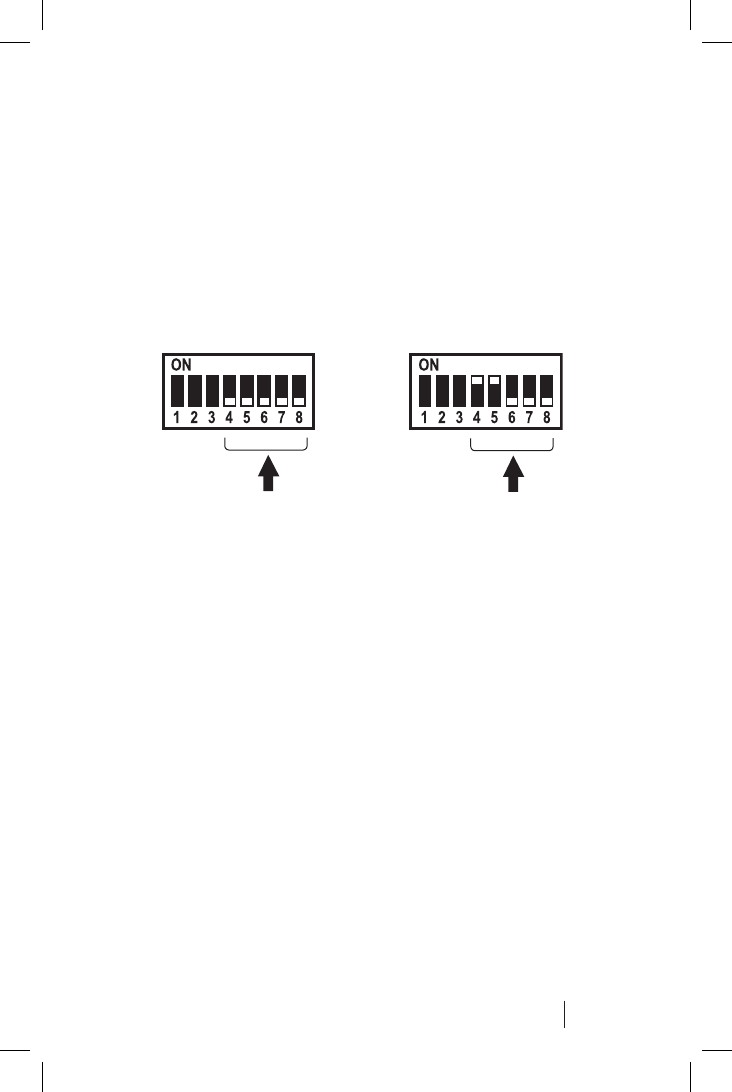
51
LATITUDE® Communicator Patient Manual
Setting Switches for Your Country
Switches 4 through 8 on the bottom of the
Communicator must be set for the country where you
are using the Communicator (Figure 8). Your
Communicator is designed to be used only in the
United States, Canada, and Puerto Rico.
CanadaUnited States,
Puerto Rico
Figure 8. Country switch settings
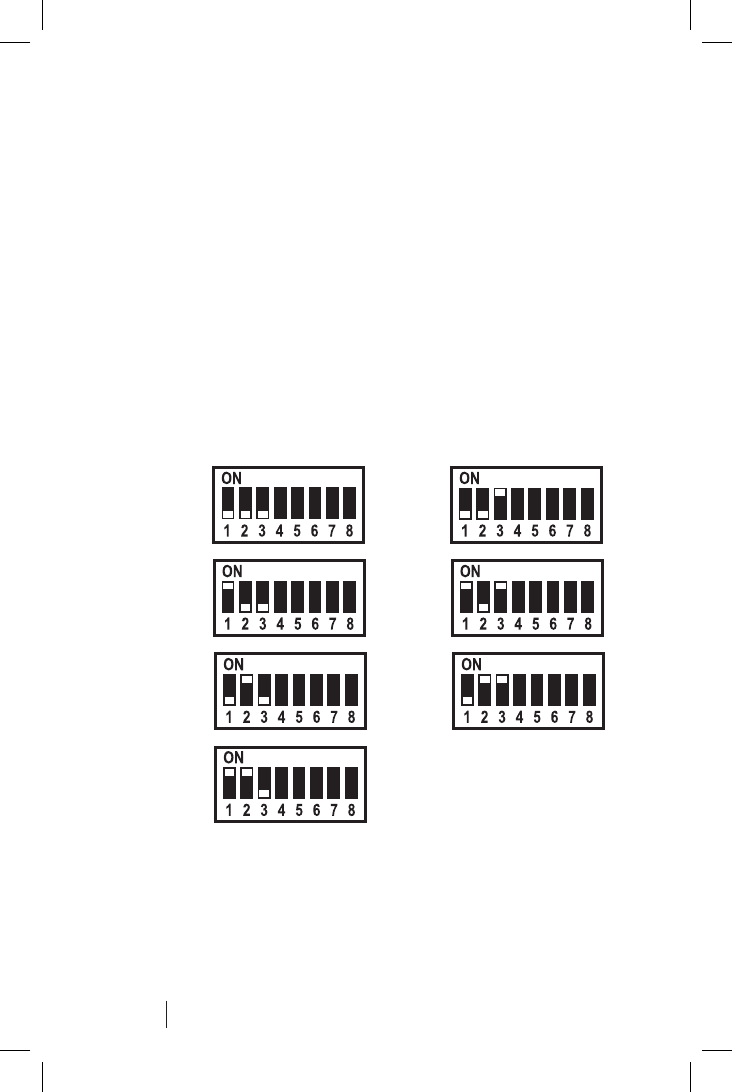
52 LATITUDE® Communicator Patient Manual
Setting Switches for PBX or Dial-out Numbers
You can use your Communicator in a managed care
facility, hotel, or other location that requires you to enter
a dial-out number or prex to place an external call.
The rst three switches (1, 2, and 3) on the bottom of
the Communicator must be set to match your dial-out
number.
Switch settings for different dial-out numbers are shown
in Figure 9. Switches 4 through 8 should be set to
match the country you are in as shown in Figure 8.
Dial-out
Number Dial-out
Number
None
0
1
7
8
9
*99
Figure 9. Dial-out number switch settings
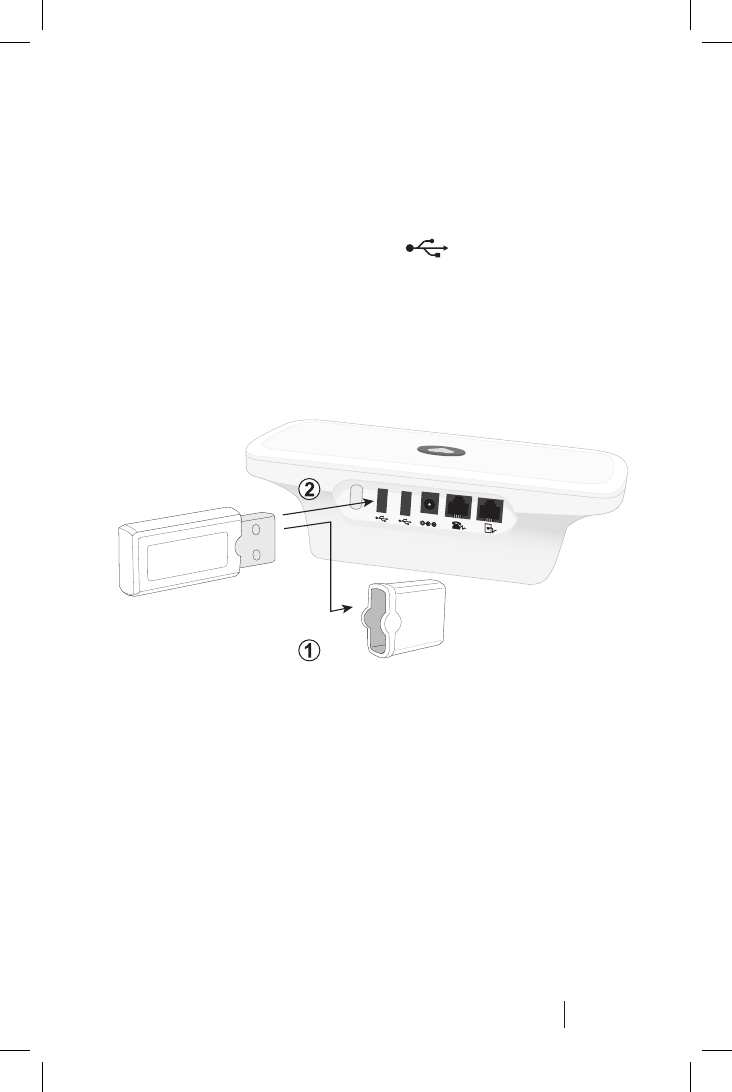
53
LATITUDE® Communicator Patient Manual
Connecting the USB Adapter
The USB adapter is included with a LATITUDE weight
scale and blood pressure monitor. The USB adapter
provides a wireless connection between these products
and the Communicator. Plug the USB adapter into
either of the USB ports labeled on the back of the
Communicator. Refer to Figure 10.
Leave the USB adapter plugged into the Communicator
so the Communicator can receive measurements
whenever you use your scale or blood pressure
monitor.
Specications
Model: 6498
Dimensions: Length: 8.00 in (20.3 cm)
Width: 4.50 in (11.4 cm)
Height: 2.71 in (6.9 cm)
Weight: 0.83 lbs ( 0.38 kg)
Figure 10. USB adapter connection

54 LATITUDE® Communicator Patient Manual
Power Source: 5.0 VDC, 3.0 A, continuous
service Class II AC adapter,
GlobTek® model GTM41060-
1505, part 358462-001
(included)
Power Supply
Input: 100-240 VAC, 0.6 A, 50-60 Hz
Maximum Output: 15 W
Supply Mains
Isolation: AC adapter plug
Minimum Operational
Loop Current: 20 mA
Expected Service Life:
Meets the useful life of the
implanted device, from 5.6 to
12.6 years
Analog dialing mode: Tone
Operating
Temperature: 41° F to 104° F (5° C to 40° C)
Storage Temperature: -13° F to 158° F
(-25° C to 70° C)
Operating Humidity: 15% to 93% noncondensing
Storage Humidity: 15% to 93% noncondensing
Storage/Operating
Pressure:
50 to 106 kPa
Protection Against
Ingress of Water: IP21 (light rain proof)

55
LATITUDE® Communicator Patient Manual
Communicator Pulse Generator Radio:
Receive Bandwidth: +190/-160 kHz
Receive Frequency: 916.5 MHz
Transmit Frequency: 916.5 MHz
Modulation Transmit Type: ASK (Amplitude-Shift keying)
Effective Radiated Power: <-1.25 dBm (0.75 mW)
USB Adaptor:
2.4 GHz wireless USB dongle
Delta Mobile Systems model DM210
Boston Scientic model 6454 (included with LATITUDE
scale and blood pressure monitor)
Operational Frequency: 2400.0 to 2480.0 MHz
Modulation Type: Adaptive Frequency Hopping
Effective Radiated Power: 14 dBm (25 mW)
Operating Temperature: 32° F to 158° F (0° C to 70° C)
Storage Temperature: -4° F to 185° F (-20° C to 85° C)
Relative Humidity: 10% to 85% noncondensing
Cellular Radio:
GSM-850: TX 824–849 MHz, RX 869–894 MHz,
Effective Radiated Power 30.0 dBm
PCS-1900: TX 1850–1910 MHz, RX 1930–1990 MHz,
Effective Radiated Power 26.5 dBm

56 LATITUDE® Communicator Patient Manual
Safety and Standards Compliance
• Changes or modications not expressly approved
by Boston Scientic could void the user’s
authority to operate this equipment.
• The use of accessories and cables other than
those specied may result in increased emissions
or decreased immunity of the LATITUDE
Communicator. Using accessories and cables
supplied with the Communicator in other medical
equipment and systems may result in increased
emissions or decreased immunity of the other
medical equipment or systems.
• Keep your Communicator and all accessories
out of the reach of small children and pets. Small
parts may cause choking or serious injury if
swallowed. Consult a health care professional
immediately if this occurs.
• Do not insert anything other than a telephone
connector into the telephone jacks on the back of
the Communicator. There can be voltage on the
electrical contacts in the connector, and there is
potential to receive a shock.
• The user is cautioned to maintain an 8 in (20 cm)
spacing from the product to ensure compliance
with FCC requirements.
• To help prevent electromagnetic interference,
it may be necessary to keep other wireless
communications equipment such as cordless
telephones and their base stations, mobile
phones and wireless home network devices at
least 11 ft (3.3 m) away from the Communicator.
• Other wireless communication equipment could
interfere with the Communicator even if the

57
LATITUDE® Communicator Patient Manual
other equipment complies with CISPR (Special
International Committee on Radio Interference)
emission requirements.
• This device complies with part 15 of the FCC
Rules. Operation is subject to the following two
conditions: (1) This device may not cause harmful
interference, and (2) this device must accept any
interference received, including interference that
may cause undesired operation.
• If your home has specially wired alarm equipment
connected to the telephone line, ensure the
installation of the Communicator does not disable
your alarm equipment. If you have questions
about what will disable alarm equipment, consult
your telephone company or a qualied installer.
• The telephone company may make changes in
its facilities, equipment, operations or procedures
that could affect the operation of the equipment.
If this happens the telephone company will
provide advance notice in order for you to make
necessary modications to maintain uninterrupted
service. If the equipment is causing harm to the
telephone network, the telephone company may
request that you disconnect the equipment until
the problem is resolved.
• This equipment has been tested and found to
comply with applicable safety portions of the IEC
60601-1:2005 standard.
• This equipment has been tested and found to
comply with the following EMC standards: IEC
60601-1-2:2007.
• Accessory equipment connected to the analog
and digital interfaces (signal inputs and signal
outputs) must be certied according to the

58 LATITUDE® Communicator Patient Manual
respective IEC standards. Anyone who connects
additional equipment to the signal input parts
or signal output parts may congure a medical
system, and is therefore responsible that the
system complies with the requirements of clause
16 of IEC 60601-1:2005. If in doubt, consult
the technical service department or your local
representative.
Software
The software included in this product contains
copyrighted software that is licensed under the GNU
General Public License (GPL). Under the terms of the
GPL as published by the Free Software Foundation you
may obtain the complete Corresponding Source code
from us for a period of three years after our shipment of
this product.
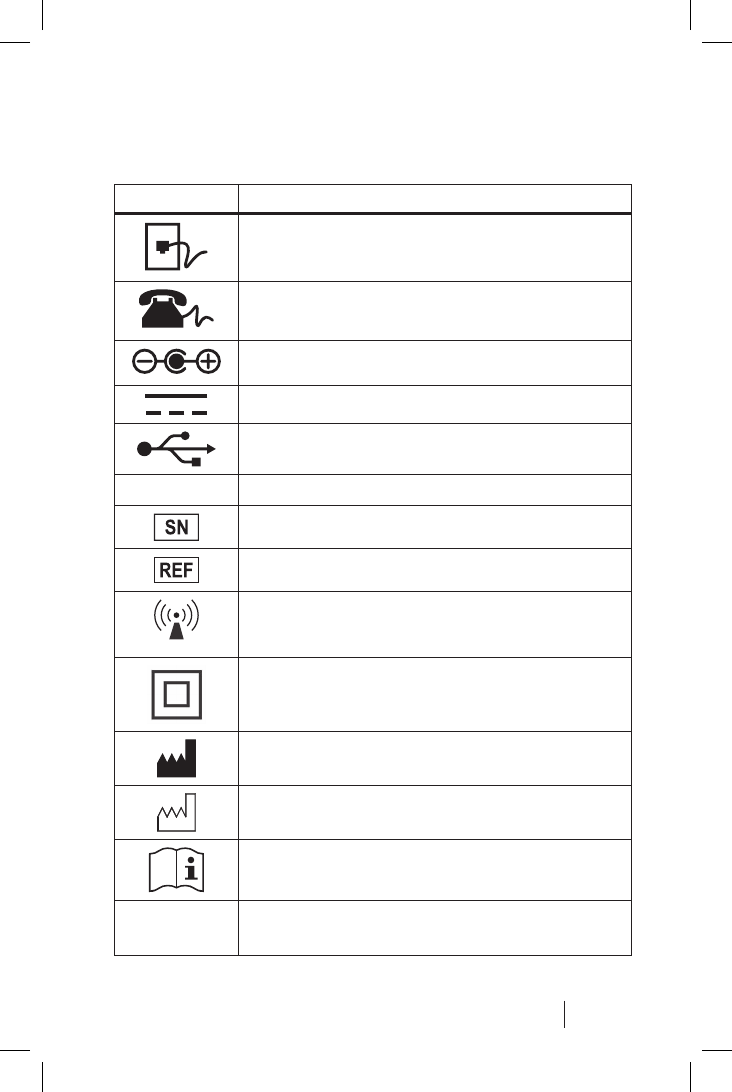
59
LATITUDE® Communicator Patient Manual
Explanation of Product and Label
Symbols
Symbol Meaning
Input from telephone jack
Output to telephone (optional)
AC/DC adapter power input
Direct current (DC)
Universal Serial Bus (USB) connector
P/N: Part number
Serial number
Reference number
Non-ionizing electromagnetic radiation
IEC 60601 Class II medical equipment,
protection against electrical shock
Manufacturer
Date of manufacture
Consult instructions for use
IP21 Protection against ingress of water.
Light rain proof.
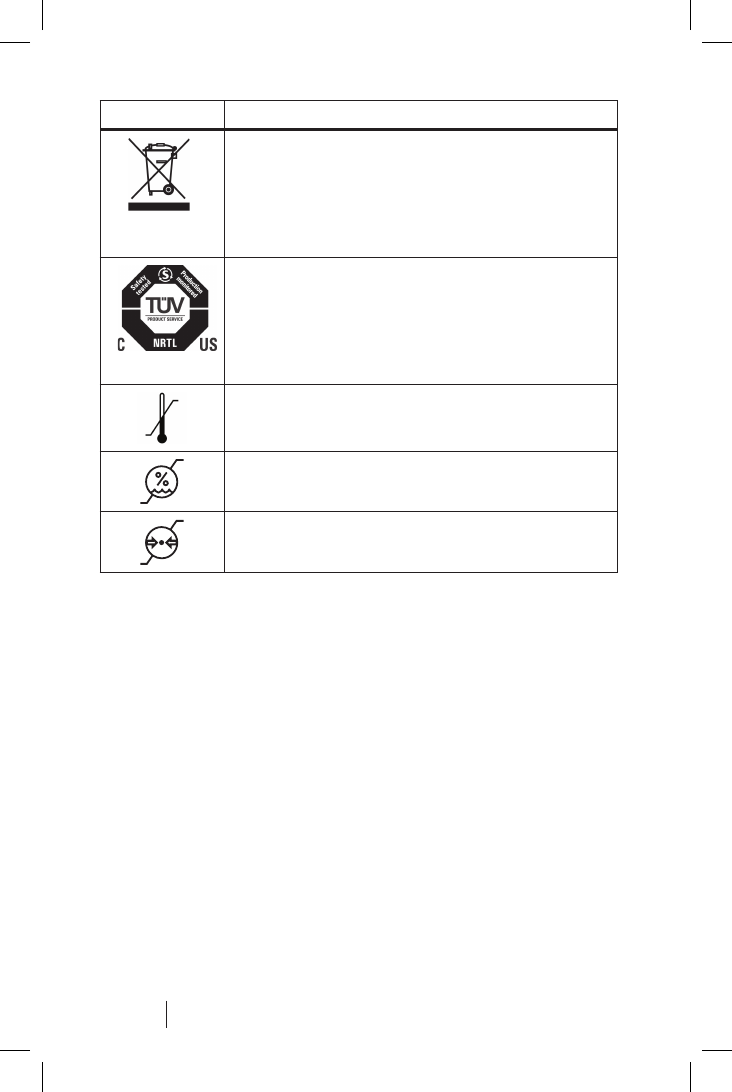
60 LATITUDE® Communicator Patient Manual
Symbol Meaning
Waste, Electrical, and Electronic
Equipment (WEEE) symbol. Indicates
separate collection for electrical and
electronic equipment (i.e., do not throw
this device in the trash)
Indicates this product has passed
a comprehensive testing procedure
and the production plant is regularly
monitored as certied by a Nationally
Recognized Testing Laboratory
Temperature range limits
Humidity range limits
Atmospheric pressure range limits


Boston Scientific
4100 Hamline Avenue North
St. Paul, MN 55112-5798 USA
Telephone: 651.582.4000
Medical Professionals: 1.800.CARDIAC (227.3422)
Patients and Families: 1.866.484.3268
www.bostonscientific.com
© 2011 Boston Scientific or its affiliates.
All rights reserved.
358736-002 ENSP US 11/11
*358736-002*